Intel Core i5-12400 vs AMD Ryzen 5 5600X Face-Off: The Gaming Value Showdown
Core i5 vs Ryzen 5 and Ryzen 7, fight!
The $199 Intel Core i5-12400 vs $299 Ryzen 5 5600X contest is a pitched battle that finds AMD's most popular CPU facing off against an Intel competitor that costs roughly $100 less at retail. That may seem odd, but AMD abandoned the sub-$200 market when it launched its Ryzen 5000 processors, leaving its older processors to hold the line as Intel opens a new front in the AMD vs Intel price wars.
Based on pricing alone, the aging Zen 2-powered Ryzen 5 3600X and 3600 will remain the go-to competitors for the 12400 even though they debuted nearly two and a half years ago. As you'll see, those old Zen 2 chips aren't competitive, and AMD's $259 Ryzen 5 5600G APU targets a different market. That means AMD's least expensive Zen 3 model, the Ryzen 5 5600X, is the 12400's only true competitor in our benchmarks.
Intel's Alder Lake chips are surprisingly powerful, already earning key upsets against higher-priced Ryzen chips on our list of Best CPUs for gaming and CPU Benchmark hierarchy. As seen in our previous faceoffs, Intel's hybrid x86 Alder Lake design, which mixes fast performance cores (P-cores) with small efficiency cores (E-Cores), represents the company's most disruptive architectural shift in a decade. As a result, Intel upsets AMD's highest-end mainstream chips, particularly in price-to-performance metrics.
- Intel Core i9-12900K vs Ryzen 9 5900X and 5950X
- Intel Core i5-12600K vs AMD Ryzen 5 5600X and 5800X
- Intel Core i7-12700K vs Ryzen 9 5900X and 5800X
However, the Core i5-12400 doesn't have a hybrid architecture. Instead, it comes with a more traditional design and only has six P-Cores active, so it doesn't use Gracemont-based cores for background tasks. That means this six-core 12-thread processor doesn't need Intel's new Windows 11-exclusive Thread Director technology to place workloads on the correct cores. As a result, unlike Intel's hybrid models, the 12400 is just as potent in Windows 10 as it is in Windows 11.
Below we've put the Core i5-12400 vs Ryzen 5 5600X through a six-round faceoff to see which chip takes the crown in our gaming and application benchmarks, along with other key criteria like power consumption and pricing. We have the final score and summary at the end of the article. Let's start with the tale of the tape.
Features and Specifications: Intel Core i5-12400 vs AMD Ryzen 5 5600X and Ryzen 5 5600G
| Row 0 - Cell 0 | Price | Cores | Threads | P-Core Base/Boost | E-Core Base/Boost | TDP / PBP / MTP | Memory Support | L3 Cache |
| Ryzen 5 5600X | $299 | 6P | 12 threads | 3.7 / 4.6 GHz | - | 65W | DDR4-3200 | 32MB |
| Ryzen 5 5600G | $259 | 6 / 12 | 3.9 / 4.4 | - | 65W | DDR4-3200 | 16MB |
| Core i5-12400 / F | $192-$199 | $167-$174 (F) | 6P + 0E | 6 Cores / 12 Threads | 4.4 / 2.5 GHz | n/a | 65W / 117W | DDR4-3200 / DDR5-4800 | 18MB |
| Ryzen 5 3600X | $240 | 6 / 12 | 3.8 / 4.4 | - | 95W | DDR4-3200 | 32MB |
| Ryzen 5 3600 | $200 | 6 / 12 | 3.6 / 4.2 | - | 65W | DDR4-3200 | 32MB |
The Core i5-12400 has six P-cores and 12 threads that operate at a 2.5 GHz base and 4.4 GHz boost clock. The chip comes armed with 18MB of L3 cache and has 65W PBP (base) and 117W MTP (peak) power ratings. The chip also comes with a bundled Laminar RM1 cooler with a semi-transparent plastic shroud and a blue ring lining the fin stack.
The Core i5-12400 is a locked chip, meaning it isn't overclockable. However, Intel supports memory overclocking on Z690, B660, and H670 motherboards (Z690 doesn't make sense for this class of chip, though). As you'll soon see, manipulating the power limits can eke out some additional performance in some types of gaming and threaded work.
The chip has the UHD Graphics 730 engine with 24 EUs running at a 300/1450 MHz base/boost frequency. If you're looking to save some coin, the graphics-less Core i5-12400F comes with a $25 price reduction and has the same specs as the 12400, which is incredibly attractive if you plan on using a discrete graphics card. Notably, you will lose Quick Sync capabilities and the iGPU fallback that you can use for troubleshooting in the event of an issue with a discrete GPU. However, there also isn't an option for graphics on AMD's Ryzen 5 5600X or the Ryzen 5 3600X and 3600, though all three of those competing chips also come with a bundled cooler.
Get Tom's Hardware's best news and in-depth reviews, straight to your inbox.
Unlike the standard Ryzen 5000 models, the Ryzen 5 5600G APU does come with integrated graphics. This Cezanne APU pairs six Zen 3 execution cores with the Radeon Vega graphics engine for iGPU-powered gaming rigs. As a result, this APU is the best value on the market if you're looking to game at lower resolutions without a discrete GPU. But aside from gaming on the iGPU, it can't compete with the Core i5-12400 and comes at a higher price point.
The 12400 goes toe-to-toe with the 6-core, 12-thread Ryzen 5 5600X that has long been the favorite for enthusiasts because of its incredible blend of pricing and performance. This chip comes with a 65W TDP rating, 32MB of L3 cache, and has only high-performance cores. It also supports DDR4-3200 memory and the PCIe 4.0 interface.
All Alder Lake chips support DDR4-3200 or up to DDR5-4800 memory (odd DDR5 population rules apply). Unfortunately, these new technologies add cost to the 600-series motherboards that house the chips, and DDR5 memory is largely unavailable. However, plenty of DDR4-powered motherboard options are available, especially with the value-centric B- and H-series chipsets that make the most sense for this class of chips. AMD also has a robust ecosystem of affordable AM4 motherboards on offer.
Winner: Intel
Intel's chip pricing is an advantage, and the 600-series platform also has a clear connectivity advantage: With DDR5 and PCIe 5.0 on the menu, AMD's AM4 platform finds itself looking a bit long in the tooth, but Intel's new features do make for more expensive motherboards. DDR5 pricing is terrible, and we expect that to continue for some time. Fortunately, the 12400 is just as fast with DDR4 in the majority of tasks, and you can pick from plenty of cost-saving DDR4 motherboards.
The Core i5-12400 comes with integrated graphics by default, though you can sacrifice those and save $25 with the Core i5-12400F. Meanwhile, you'll have to look to AMD's Ryzen 5 5600G APU if you want integrated graphics from Team Red in this price range, but that chip isn't really directly comparable to the 12400 in our performance benchmarks.
Gaming Benchmarks and Performance: Intel Core i5-12400 vs AMD Ryzen 5 5600X and Ryzen 5 5600G
This article is an overview of our much more in-depth testing in our Intel Core i5-12400 review. We're focusing on our Windows 11 test results in this article, but you should experience similar results in Windows 10. We also include tests with the Core i5-12400 with the power limits lifted and overclocked memory (again, head to the review for details).
Below you can see the geometric mean of our gaming tests with the Core i5-12400 vs the Ryzen 5 5600X and Ryzen 5 5600G at 1080p and 1440p, with each resolution split into its own chart. Notably, these results aren't too important for the 5600G — the 5600G is designed to use its integrated graphics, not a discrete GPU, and easily beats the 12400 in every iGPU contest (You can see an example of that here). As per usual, we're testing with an Nvidia GeForce RTX 3090 to reduce GPU-imposed bottlenecks as much as possible, and differences between test subjects will shrink with lesser cards or higher resolutions.




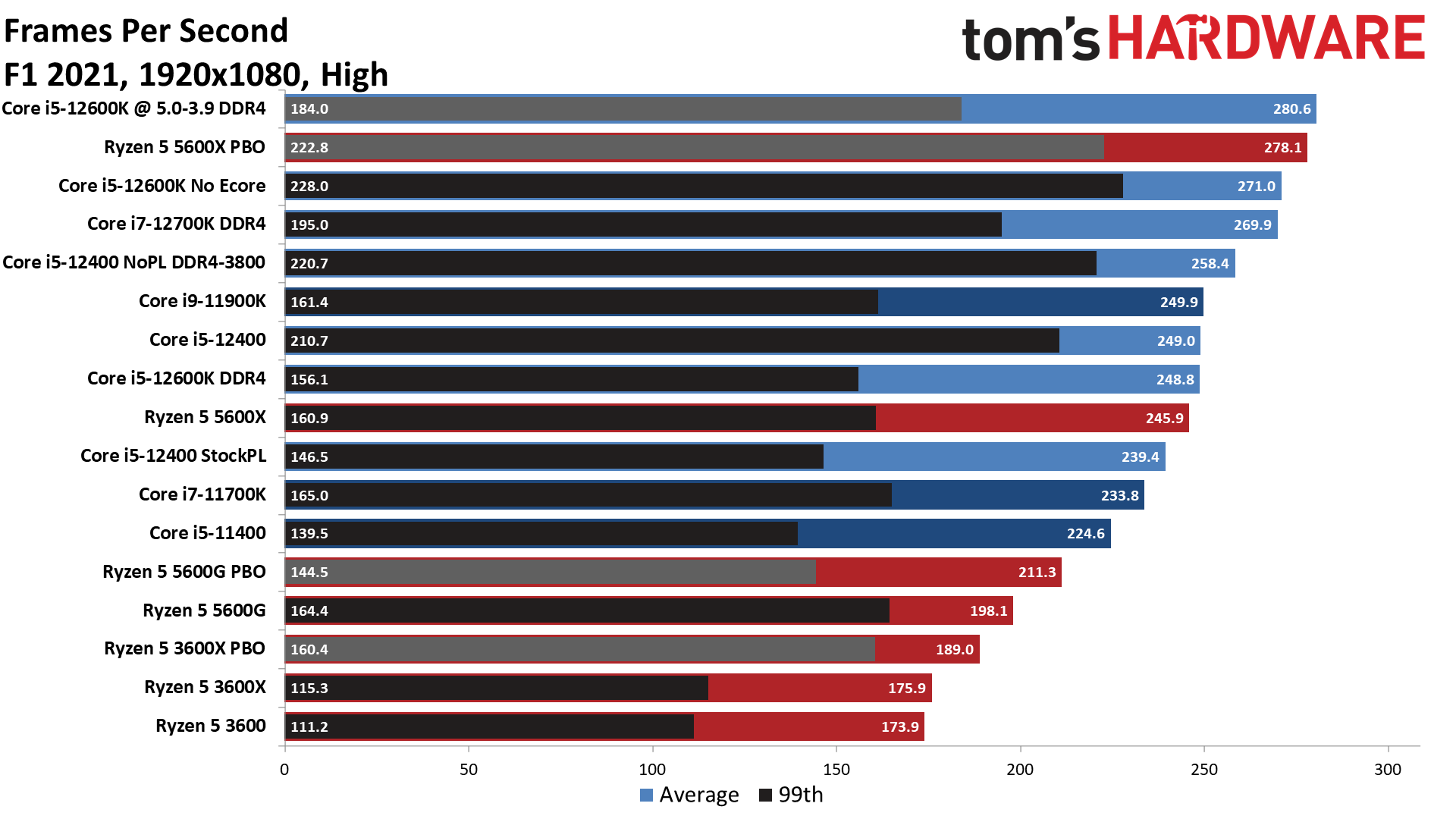


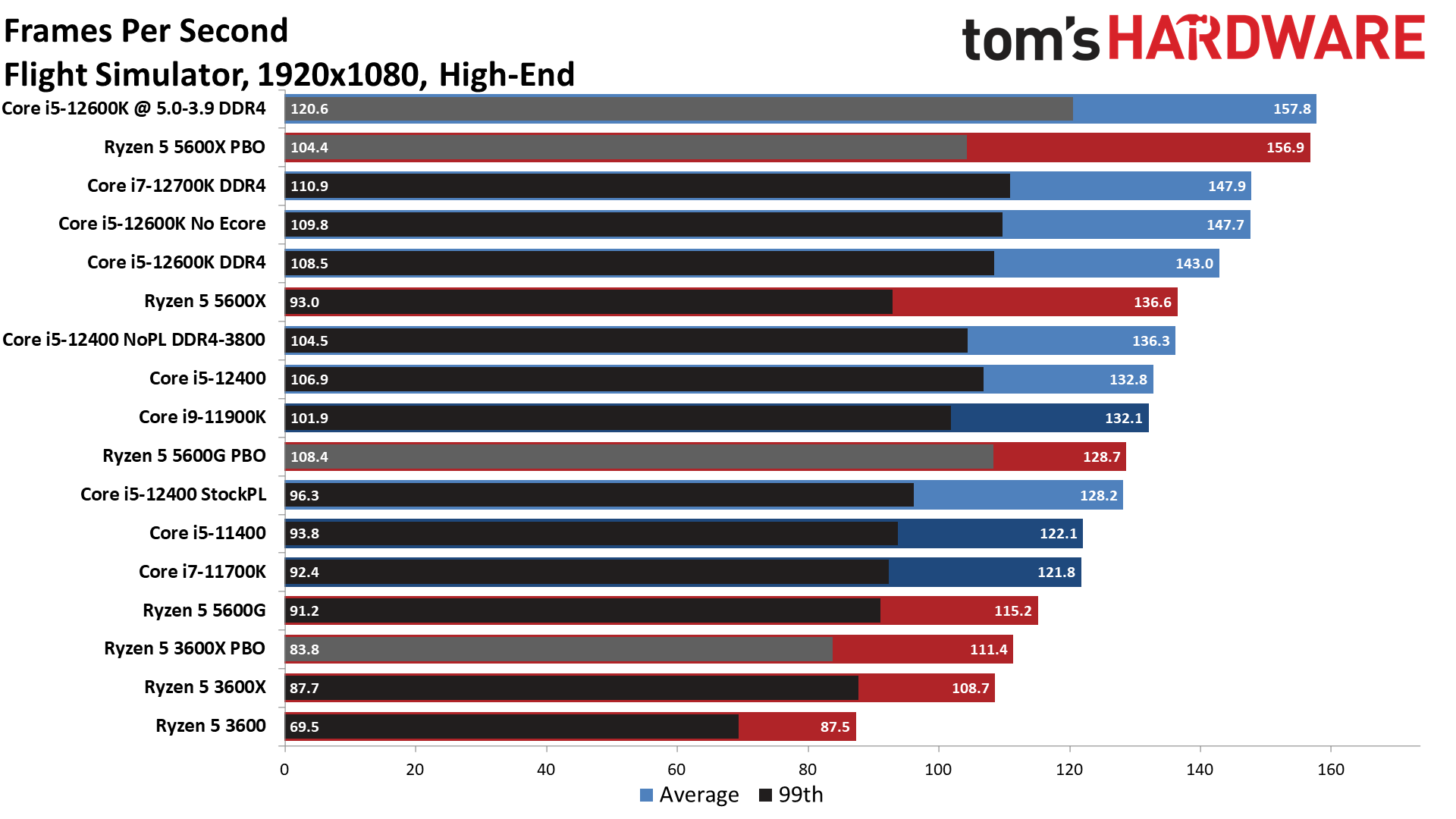
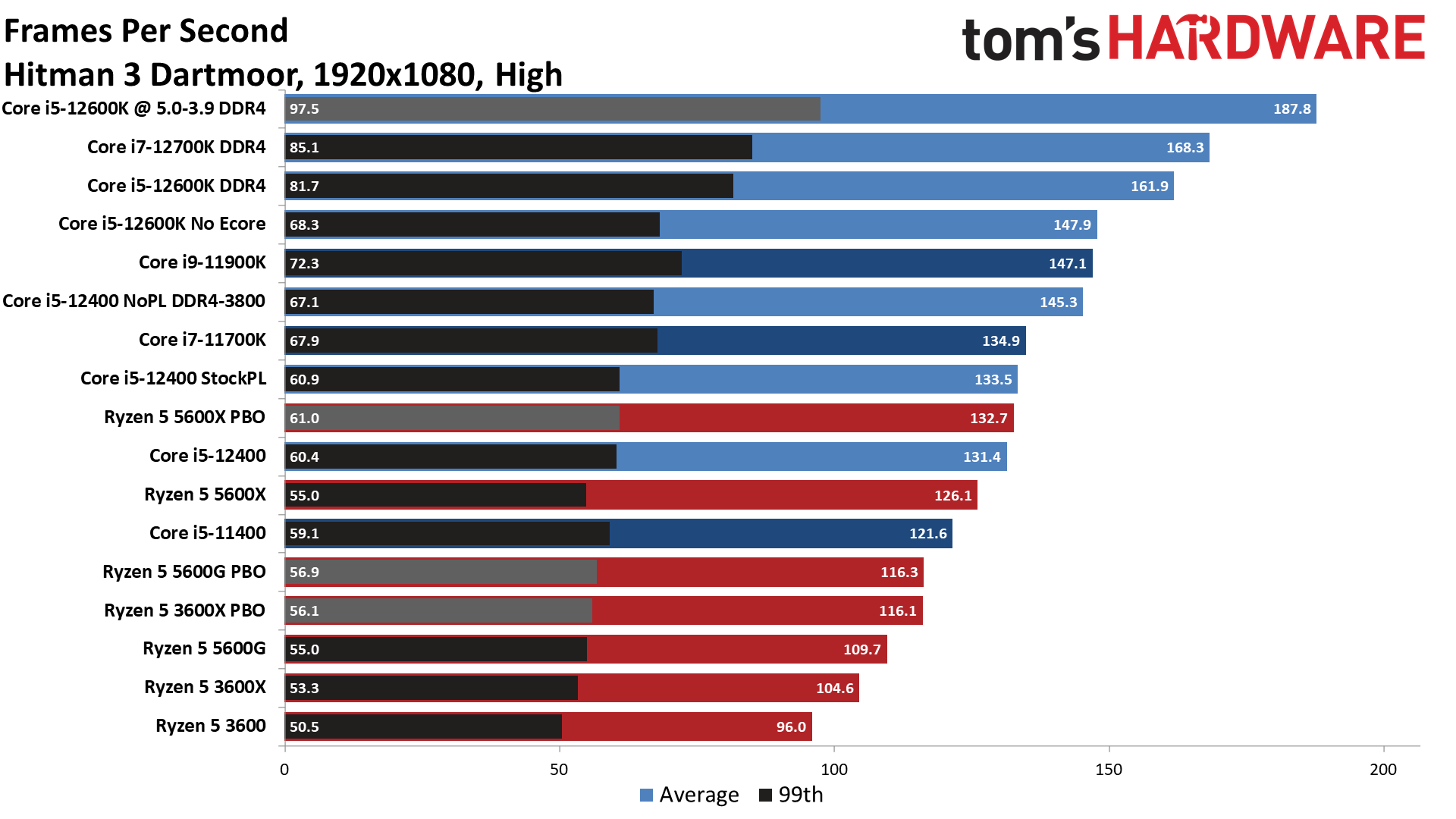
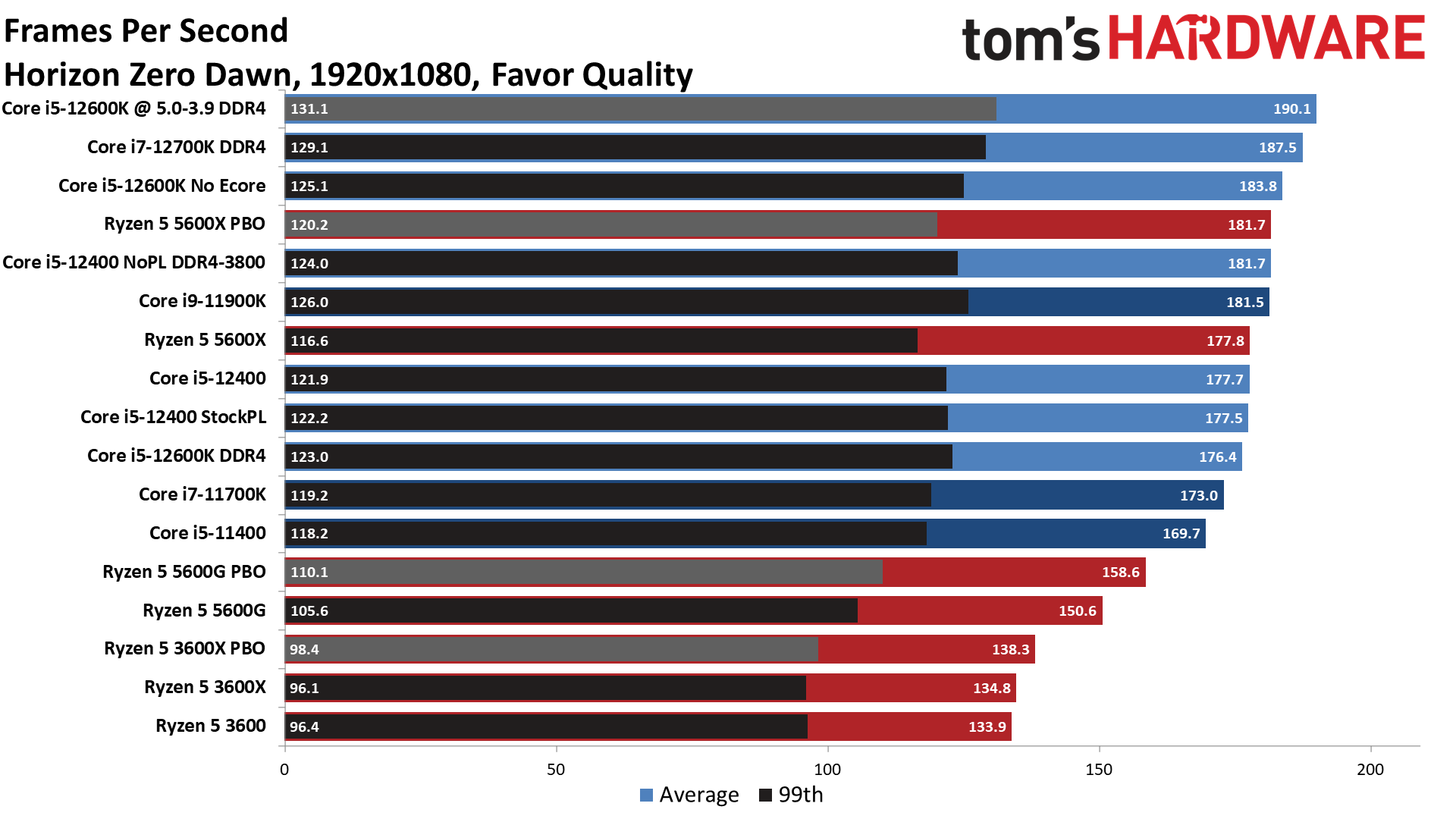

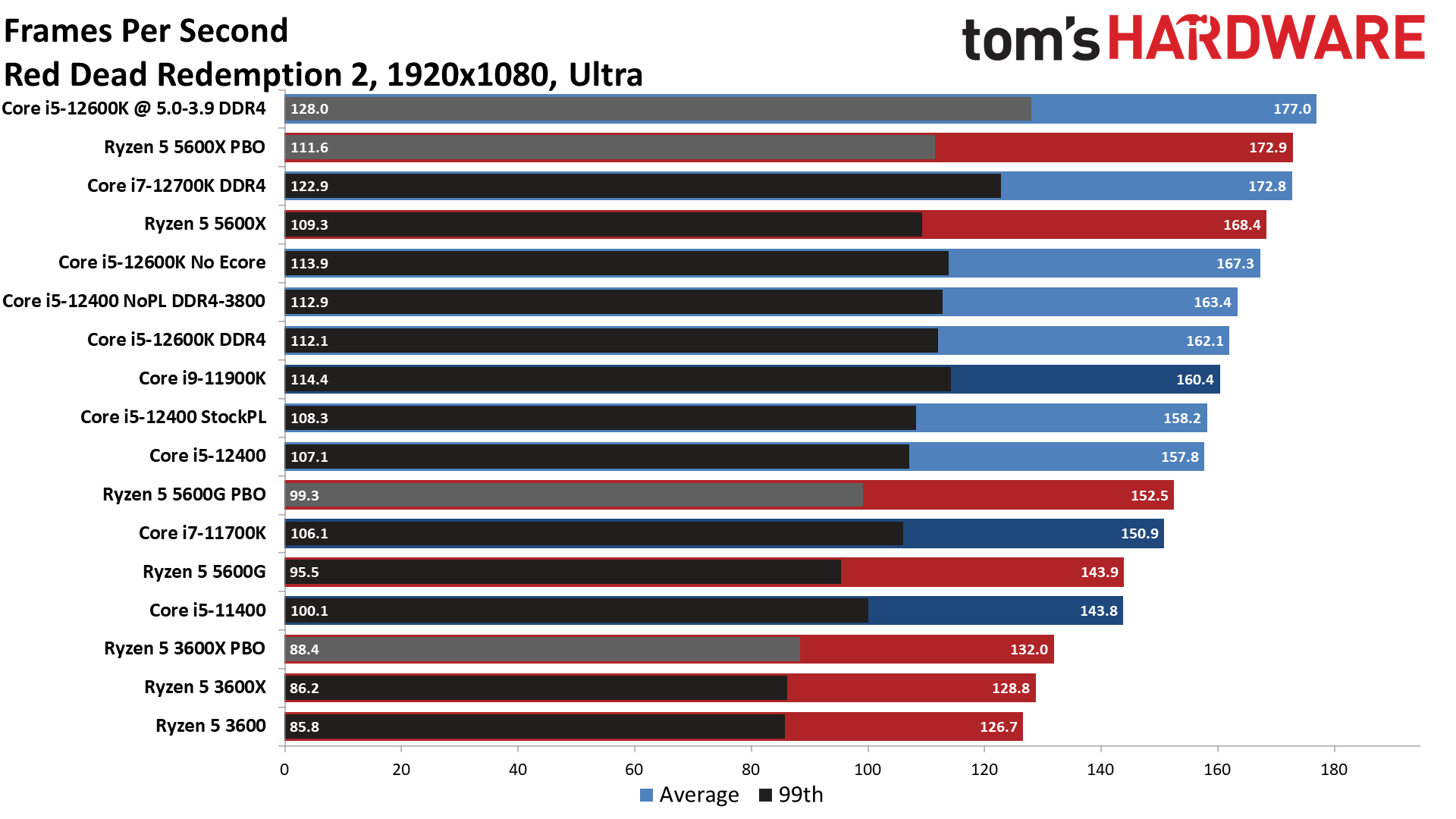
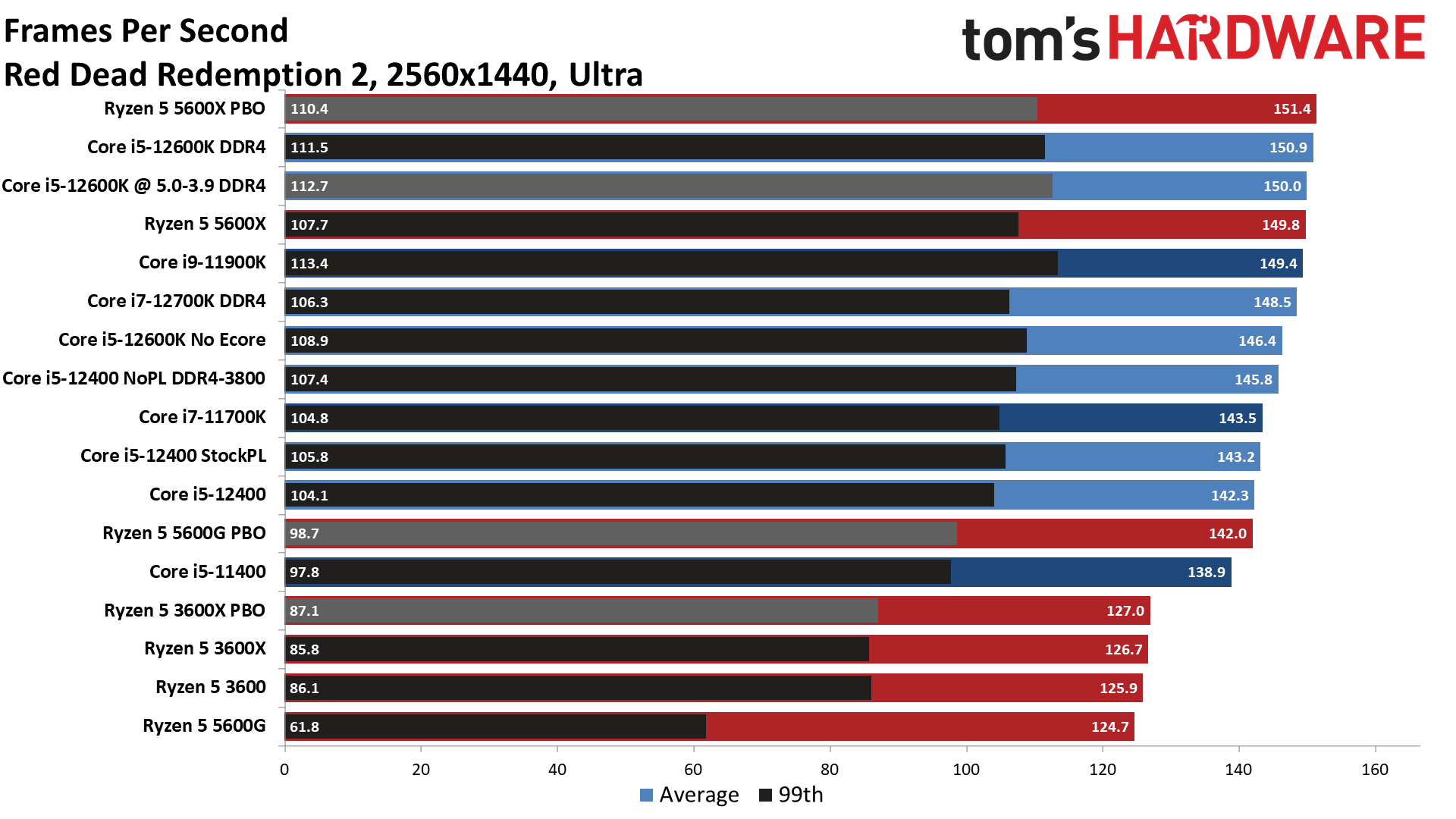
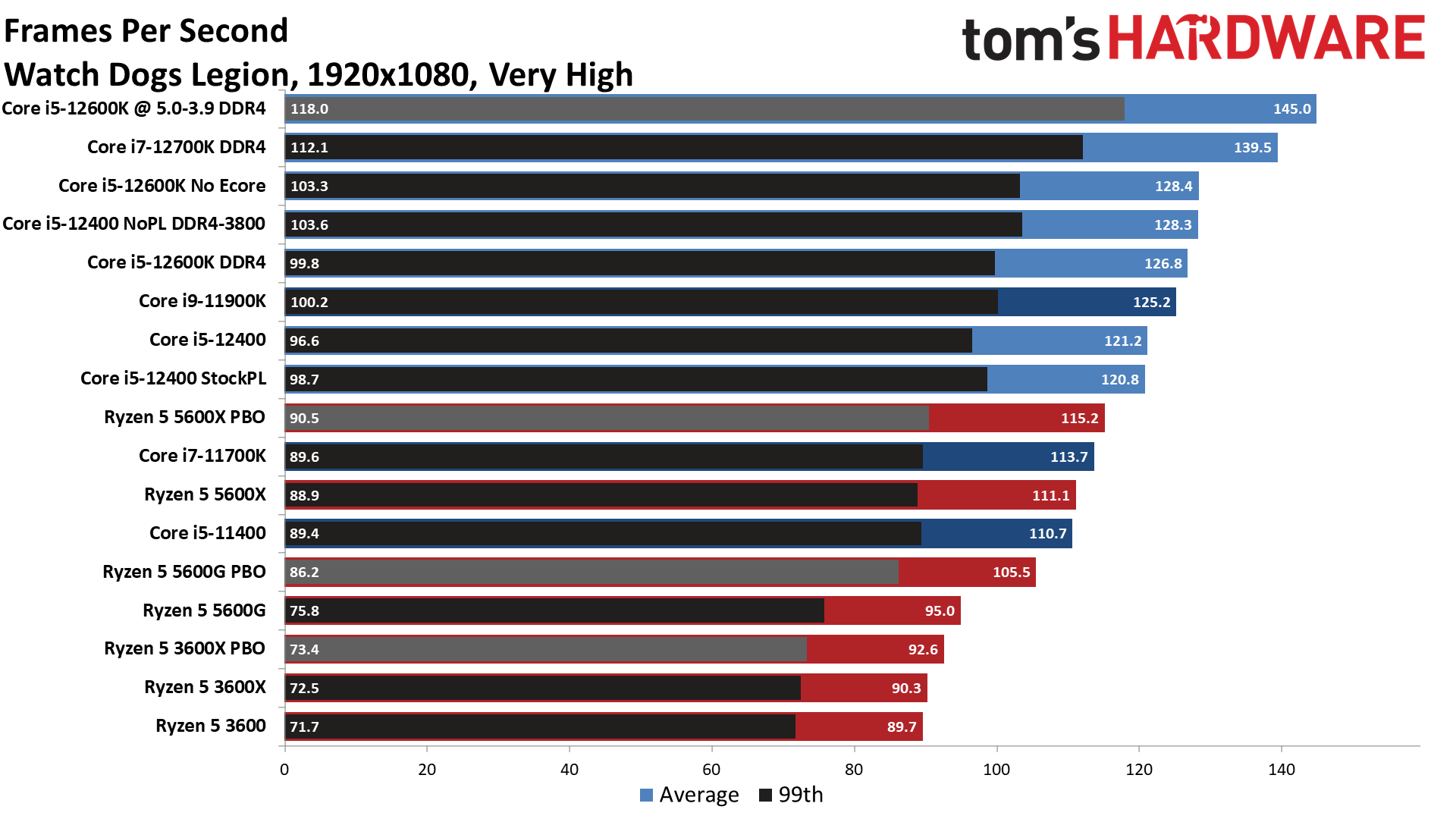

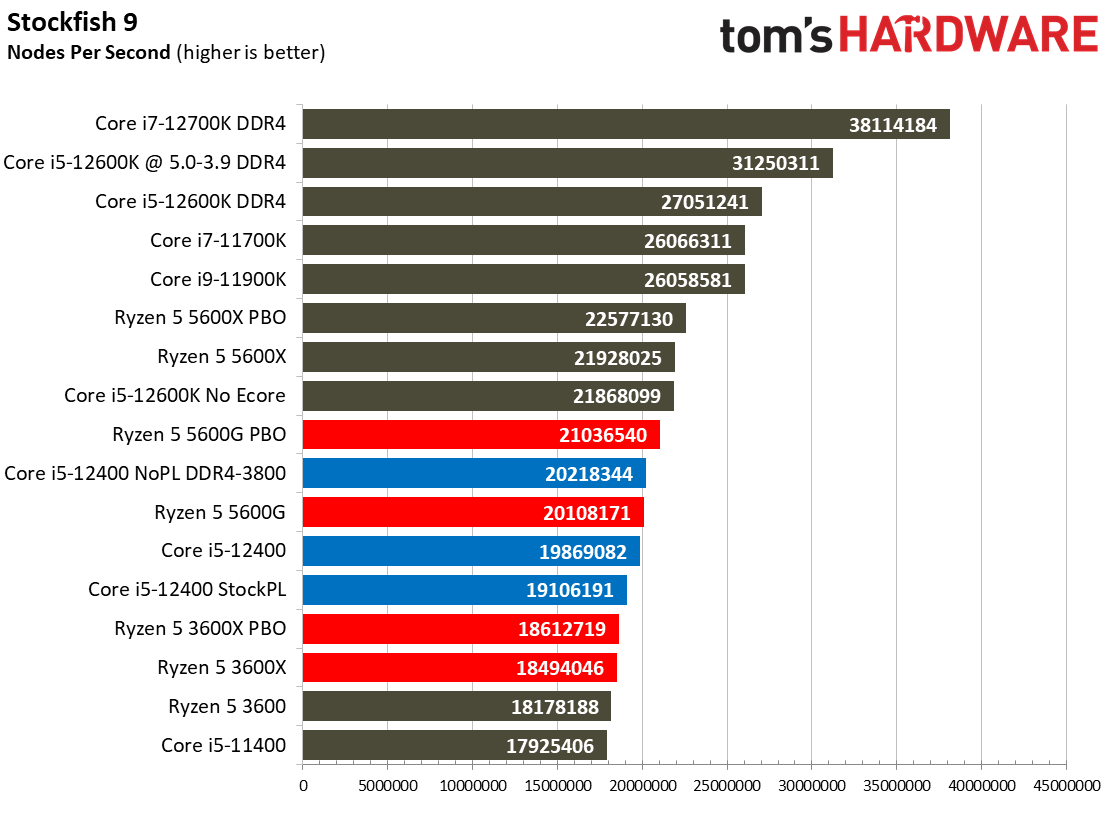
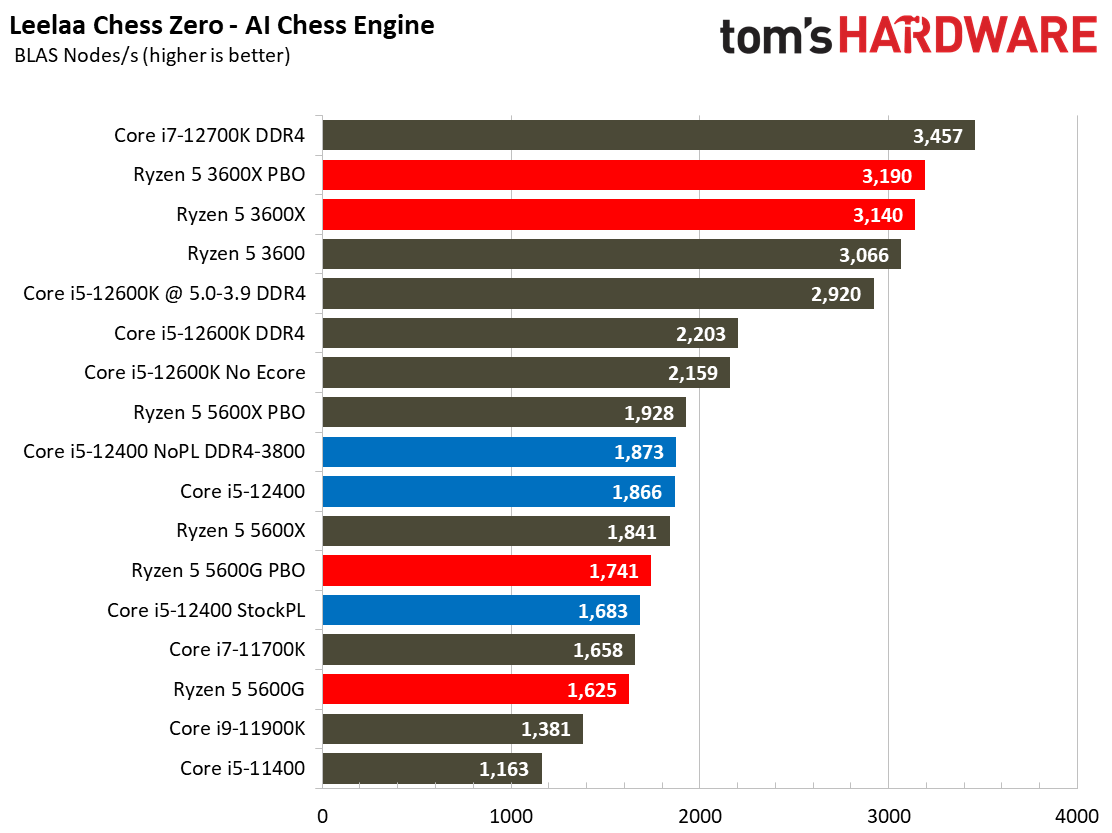



Paired with affordable DDR4 memory at the 1080p resolution, the previous-gen flagship $584 Core i9-11900K is a scant 2.5% faster than the $199 Core i5-12400, but tuning the Core i5's memory to DDR4-3800 gives it a 1.9% lead over the stock 11900K in our cumulative performance measurement. Even though the 11900K would take the lead after overclocking, that's an incredible gen-on-gen improvement in performance.
At 1080p, the Core i5-12400 at stock settings is 1.9% faster than AMD's venerable ~$299 Ryzen 5 5600X. After tuning, the Core i5-12400 ties the overclocked 5600X, an impressive showing for a chip that costs $100 less.
It's a bit unfair to compare the $259 Ryzen 5 5600G to the Core i5-12400; AMD's APU isn't designed as a direct competitor and is more expensive than the 12400. However, aside from the Ryzen 5 3600X and 3600, the $259 5600G is the only AMD processor close to this price class. Regardless, with a discrete GPU, the Core i5-12400 is 16.8% faster than the 5600G and 14% faster after tuning both chips. However, if you're looking for the best performance without a discrete GPU, the Ryzen 5 5600G outclasses the 12400.
The Ryzen 5 3600X and 3600 also feel like odd comparisons to the 12400 — both are several years old and have the previous-gen Zen 2 architecture. But, again, these are the only suitable comparables from the AMD camp. The Core i5-12400 is 22.7% and 26% faster than the Ryzen 5 3600X and 3600, respectively. As you can imagine, overclocking the Ryzen chips doesn't do much to close that chasm.
Naturally, moving over to 1440p pushes the bottleneck to the GPU, so the difference between the chips shrinks tremendously. Gamers with lower-resolution panels with high refresh rates will benefit more from Alder Lake's faster frame rates. Flipping through the 99th percentile charts shows larger deltas between the chips, but Windows 11 seems to suffer from more framerate variability than Windows 10.
The AMD vs Intel gaming competition is closer now, with some games favoring one architecture over the other. As such, it's best to make an informed decision based on the types of games that you play frequently. Be sure to check out the individual tests in the above album. It's noteworthy that the synthetic benchmarks (Futuremark suite and chess benchmarks) don't tend to translate well to real-world gaming, but they do show us the raw amount of compute power exposed to game engines.
Winner: Intel
The Core i5-12400 leads convincingly over all of the chips in its price class and also punches up to beat the Ryzen 5 5600X and the 5600G at stock settings. It even stands toe-to-toe with the $100 more expensive 5600X after tuning. The Ryzen 5 3600X and 3600 shouldn't be asked to face the 12400, they aren't in the same performance class, but AMD's decision to abandon the low-end market makes this an unfortunate reality.
Overall it's clear that the Core i5-12400 is now the value gaming champion, offering a superior level of performance at its price point with no clear price/performance competitors.
Application Performance: Intel Core i5-12400 vs AMD Ryzen 5 5600X and Ryzen 5 5600G
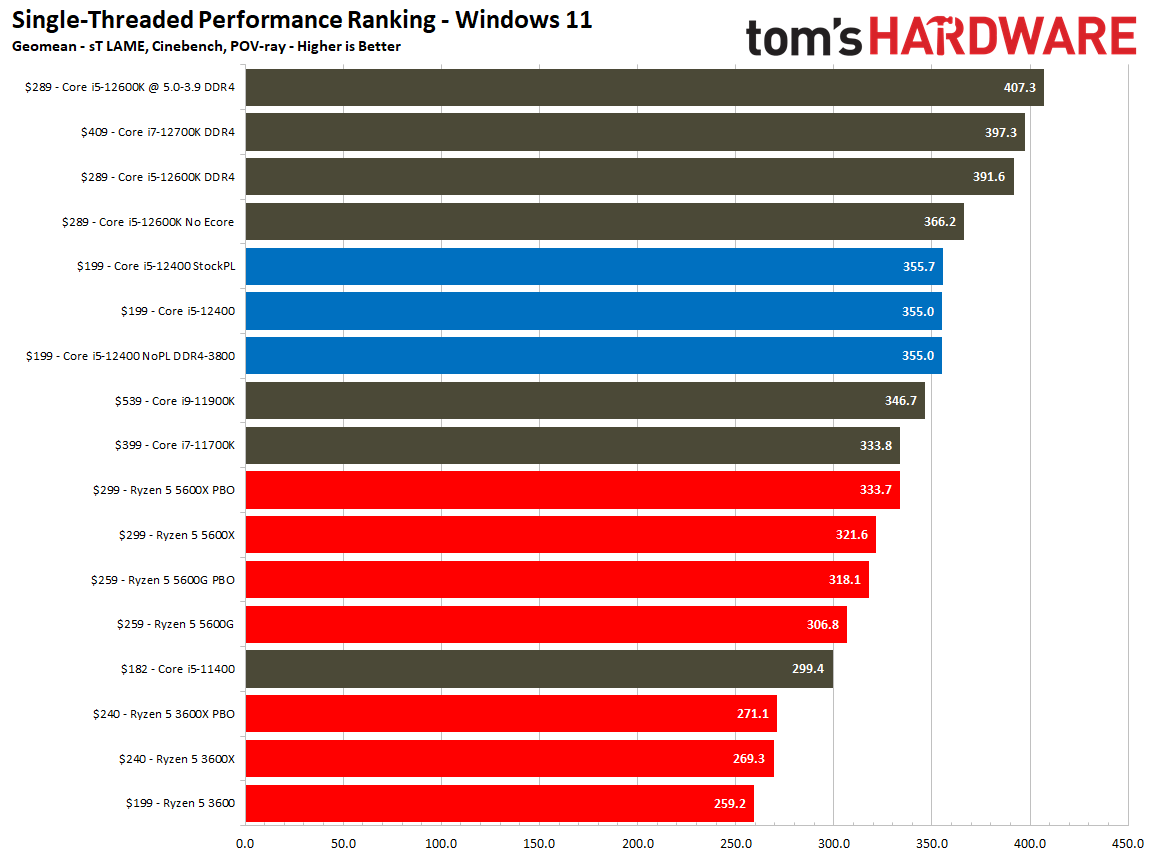
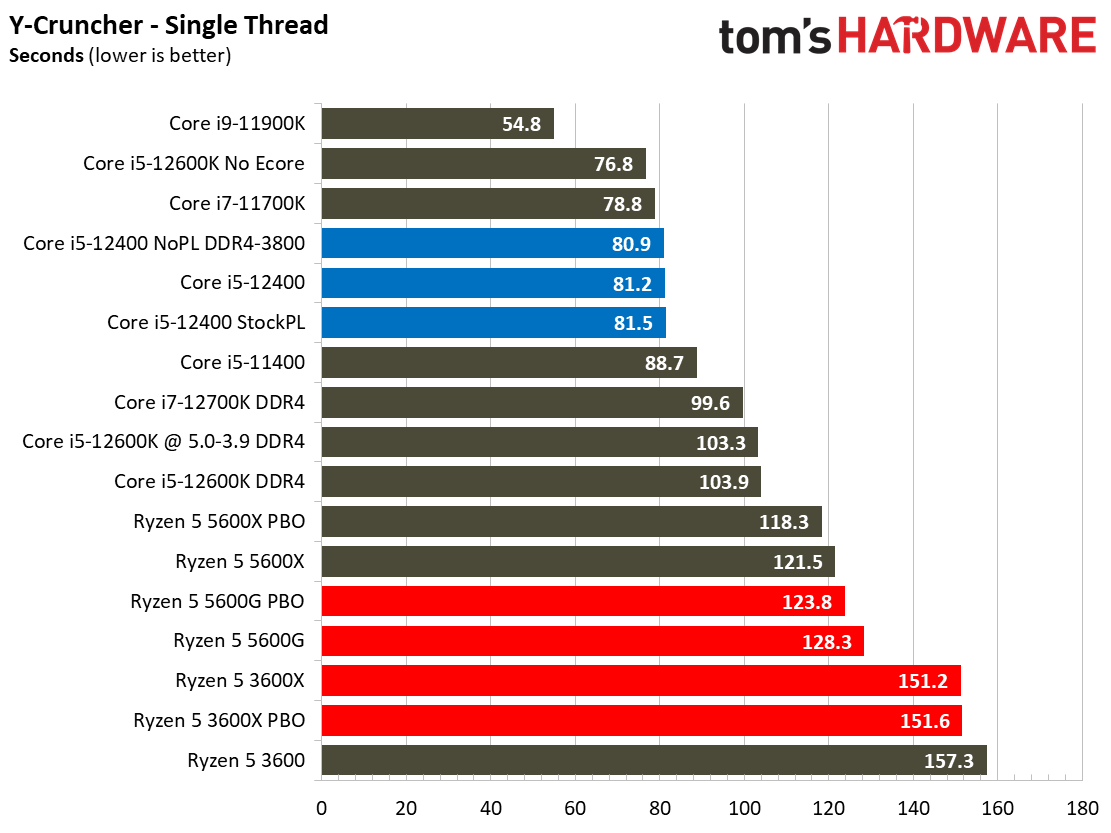
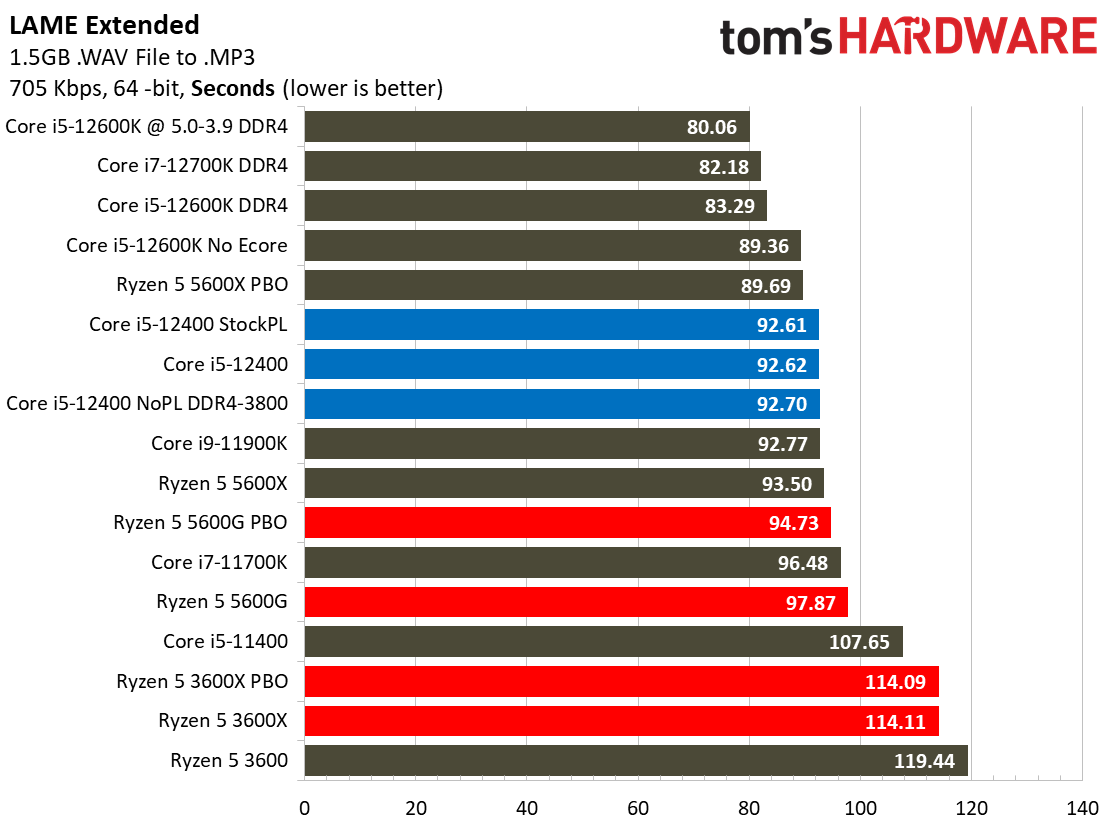
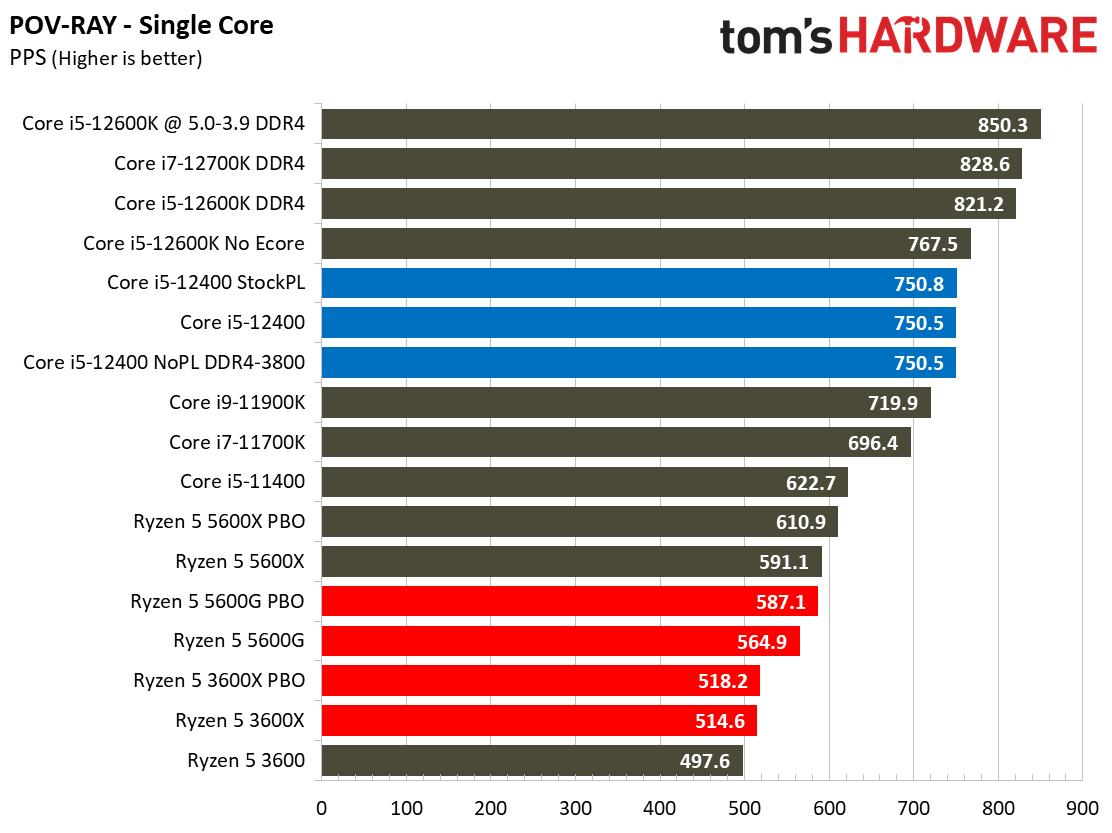
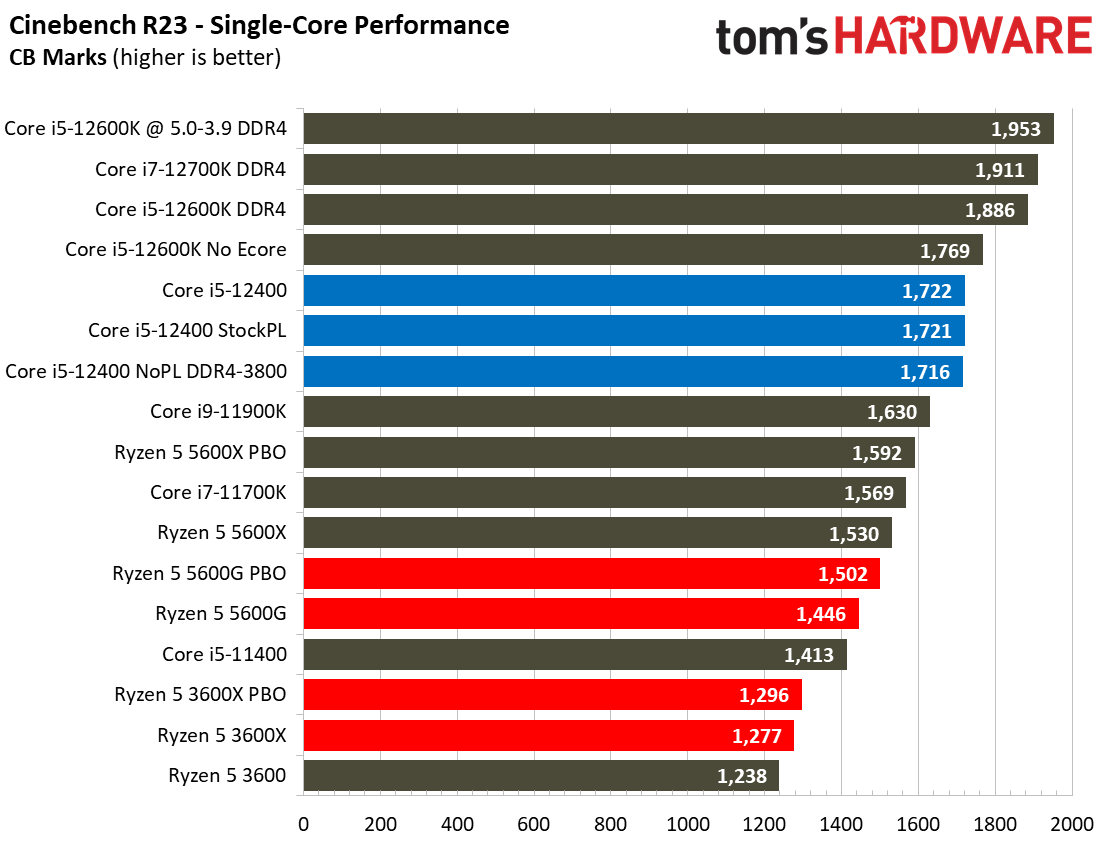
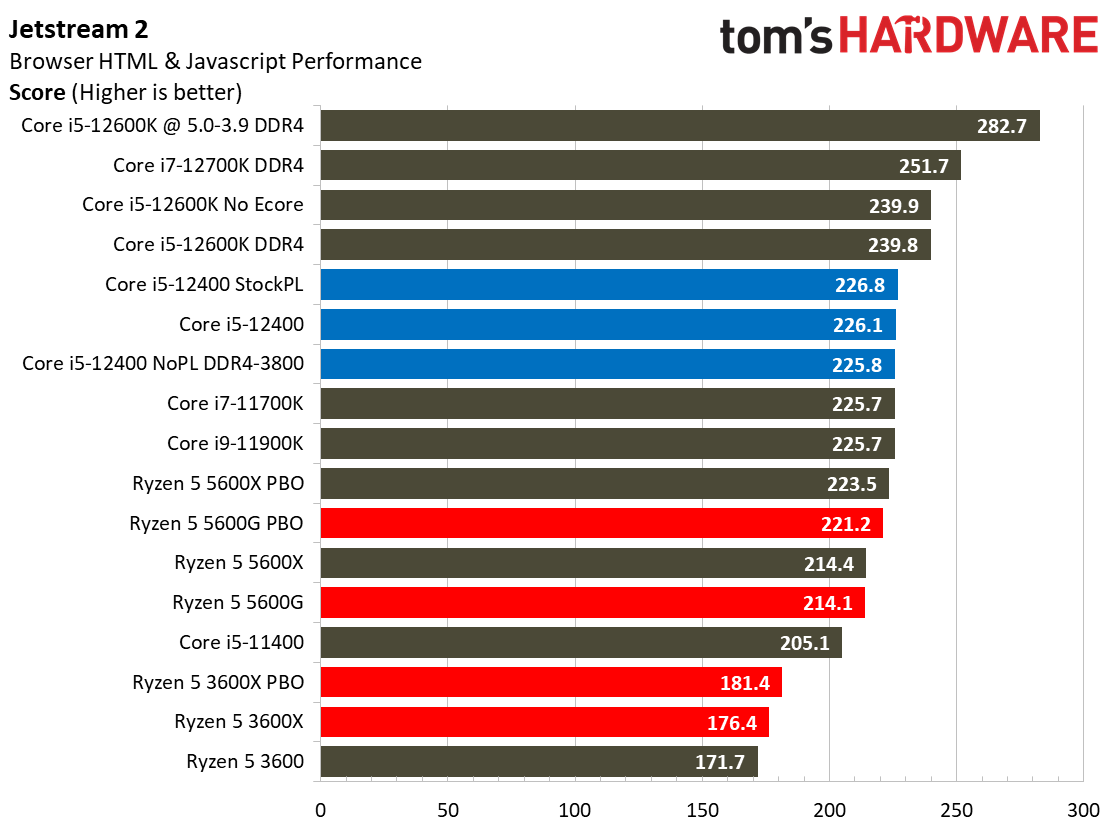
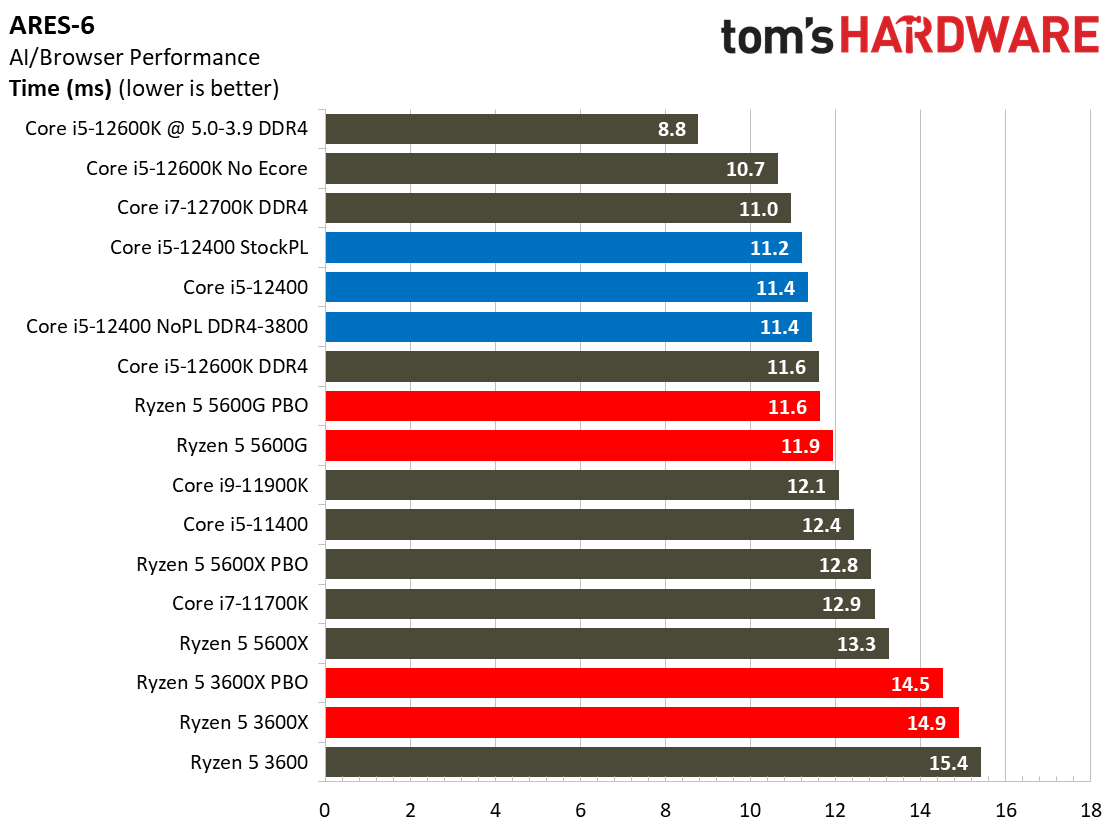
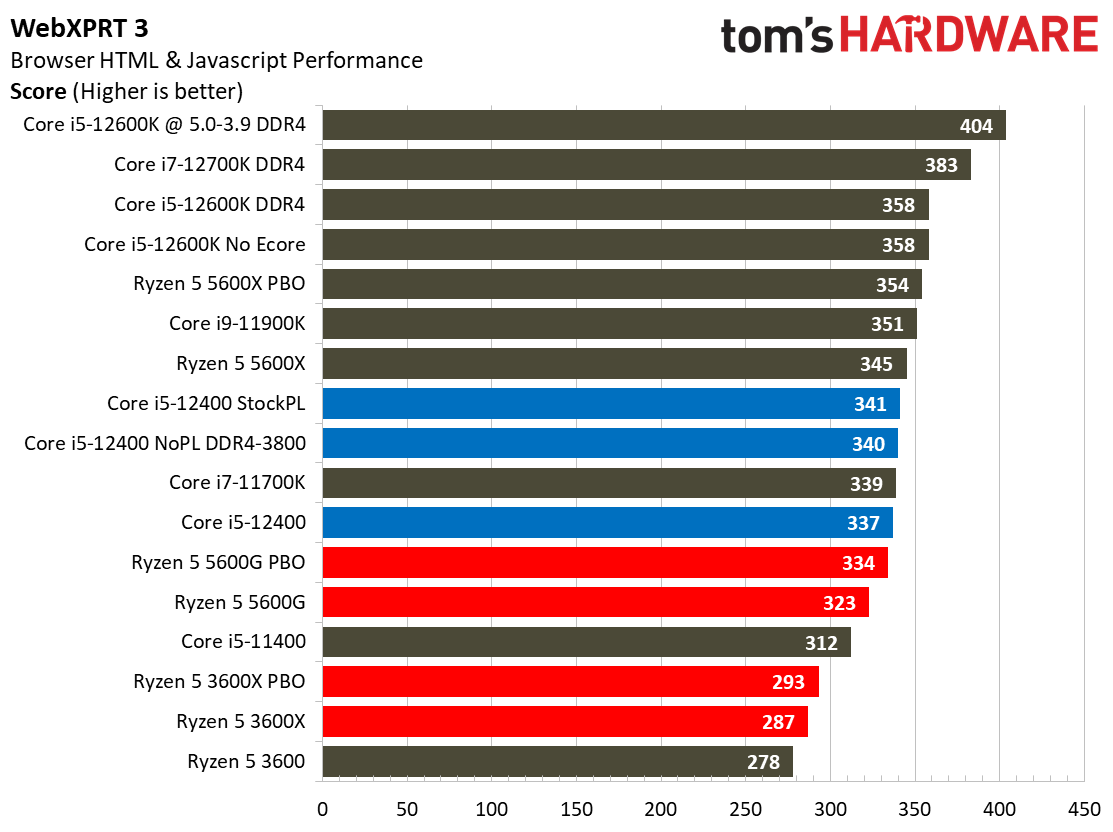

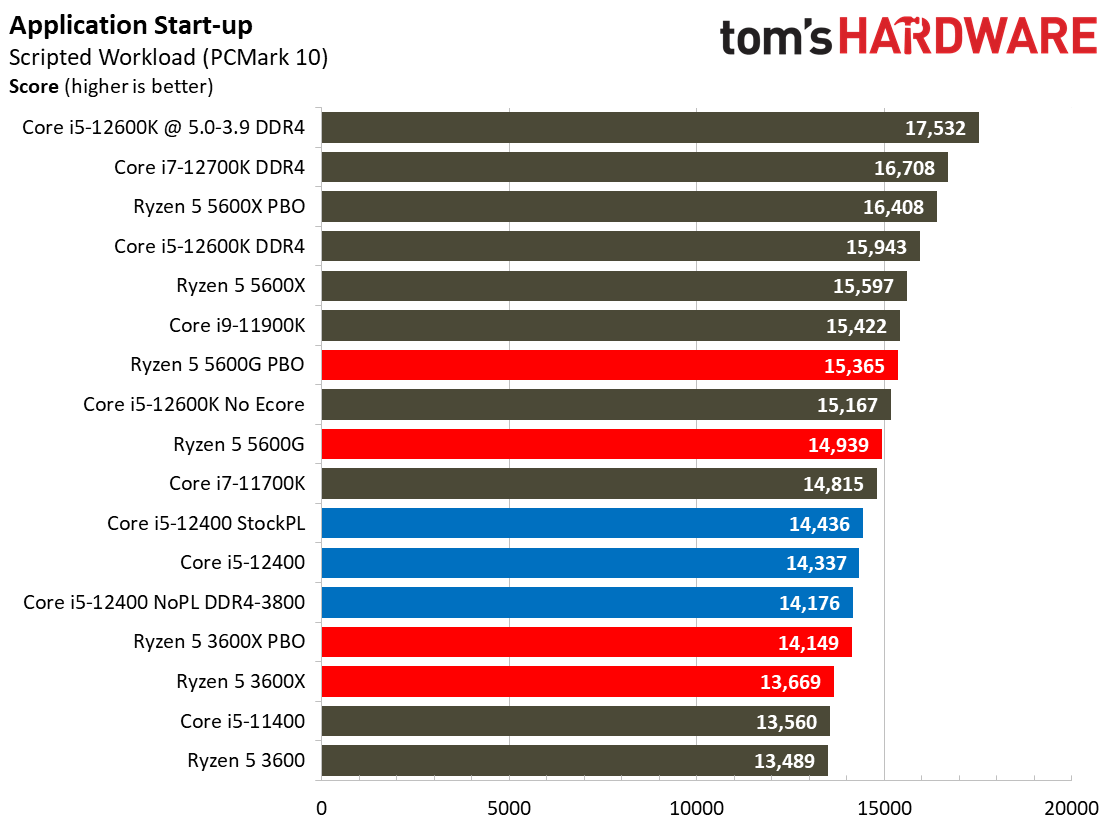
We can boil down productivity application performance into two broad categories: single- and multi-threaded. The first slide above shows the geometric mean of performance in several of our most important tests in the single-threaded category, but be sure to look at the expanded results below.
The Core i5-12400 is 13.5% faster than the Ryzen 5 5600G in single-threaded work (10% faster after tuning the 5600G), and a whopping 24% and 27% faster than the Ryzen 5 3600X and 3600, respectively. You'll have to look to other Alder Lake chips to find faster performance in single-threaded work: As you can see in our CPU Benchmark hierarchy, even the beastly $799 Ryzen 9 5950X can't match the Core i5-12400 in single-threaded tasks.
As expected, we don't see a significant difference between the 12400's different power/memory settings, which has more impact on threaded work and gaming, but the 12400 doesn't need much help. The chip is 2.3% faster than the Core i9-11900K, 6% faster than the 11700K, and an incredible 15.7% faster than the 11400.
This superior performance in lightly-threaded apps will equate to a snappier, faster experience in all manner of light day-to-day tasks. The 12400's snappy performance will be most noticeable in gaming, web browsers, and application start-up tasks.

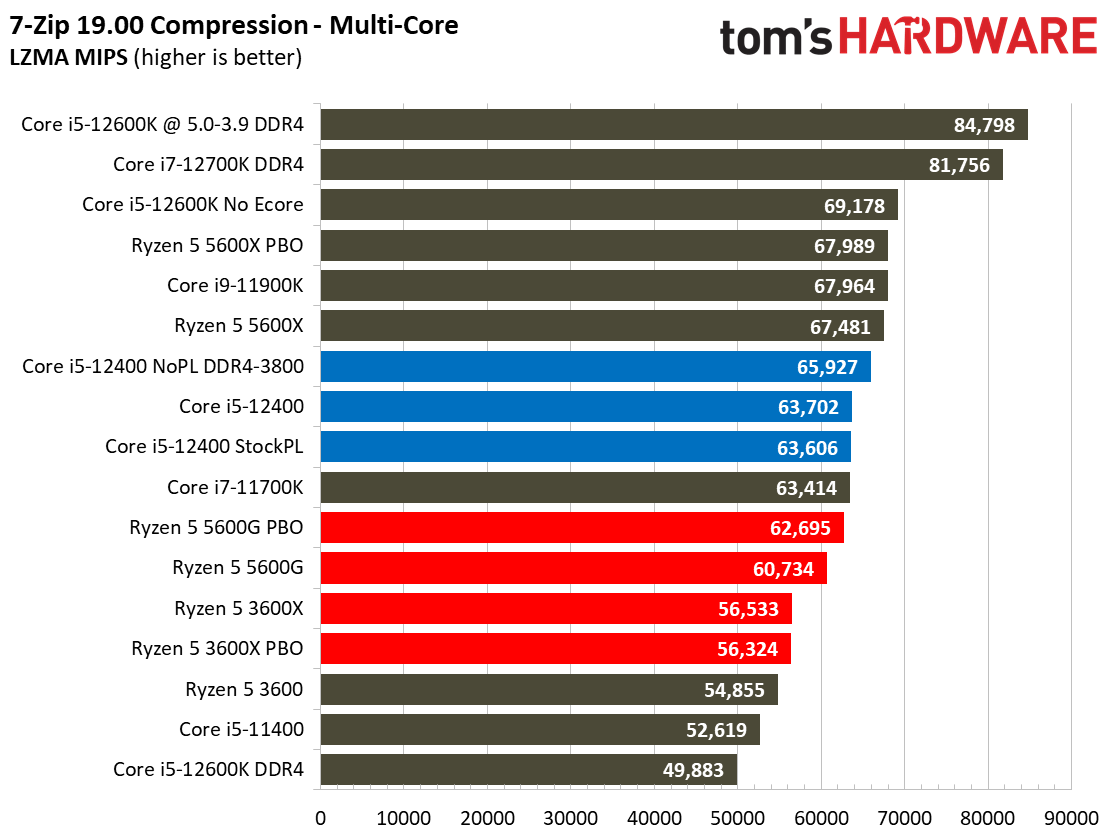
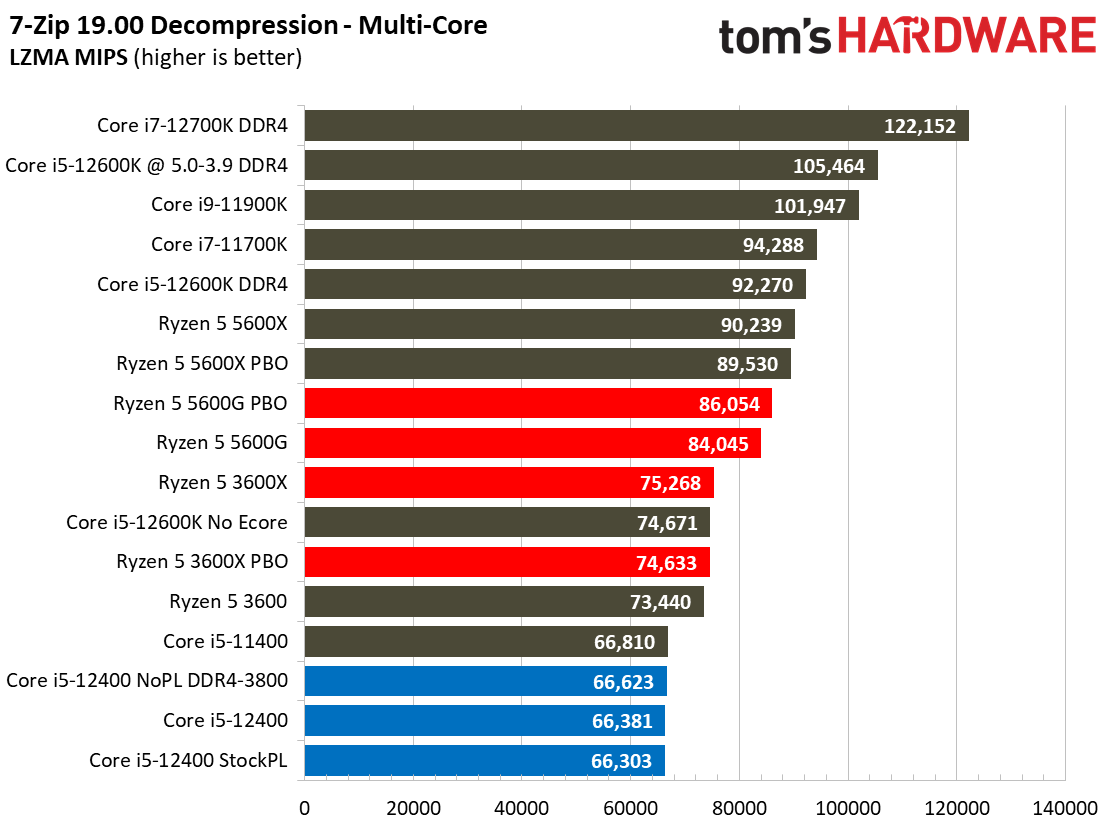
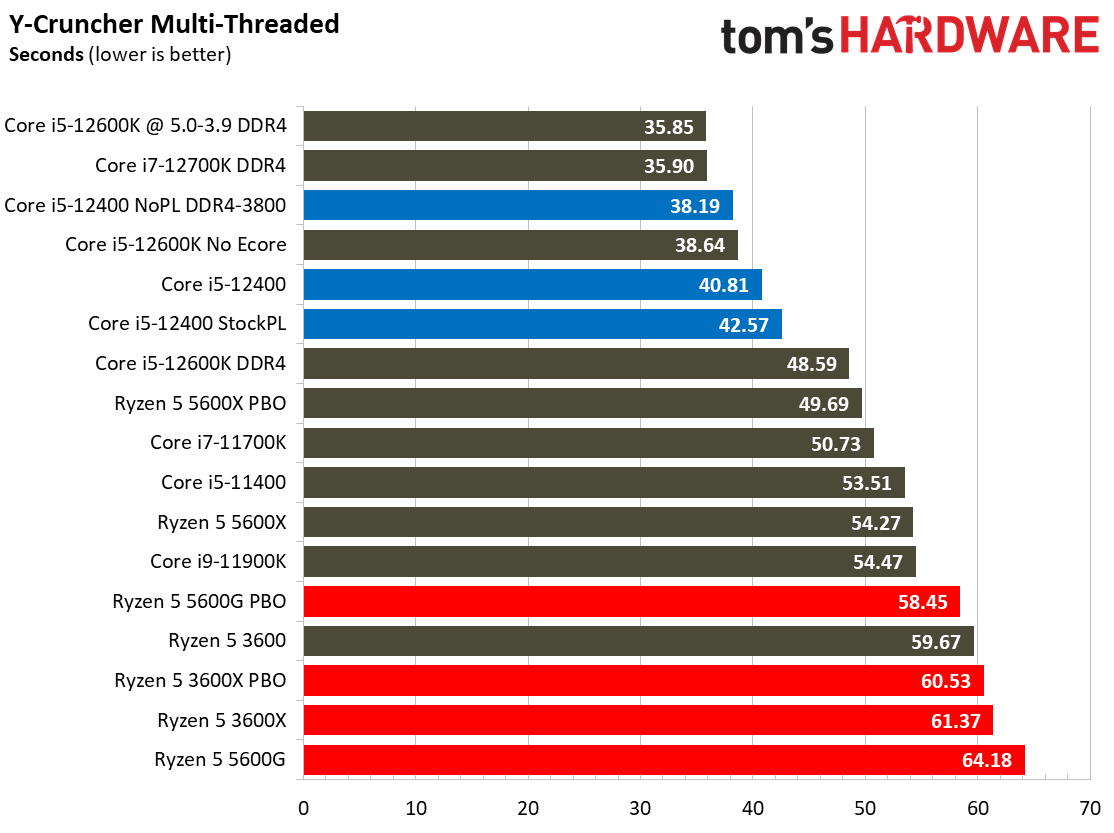

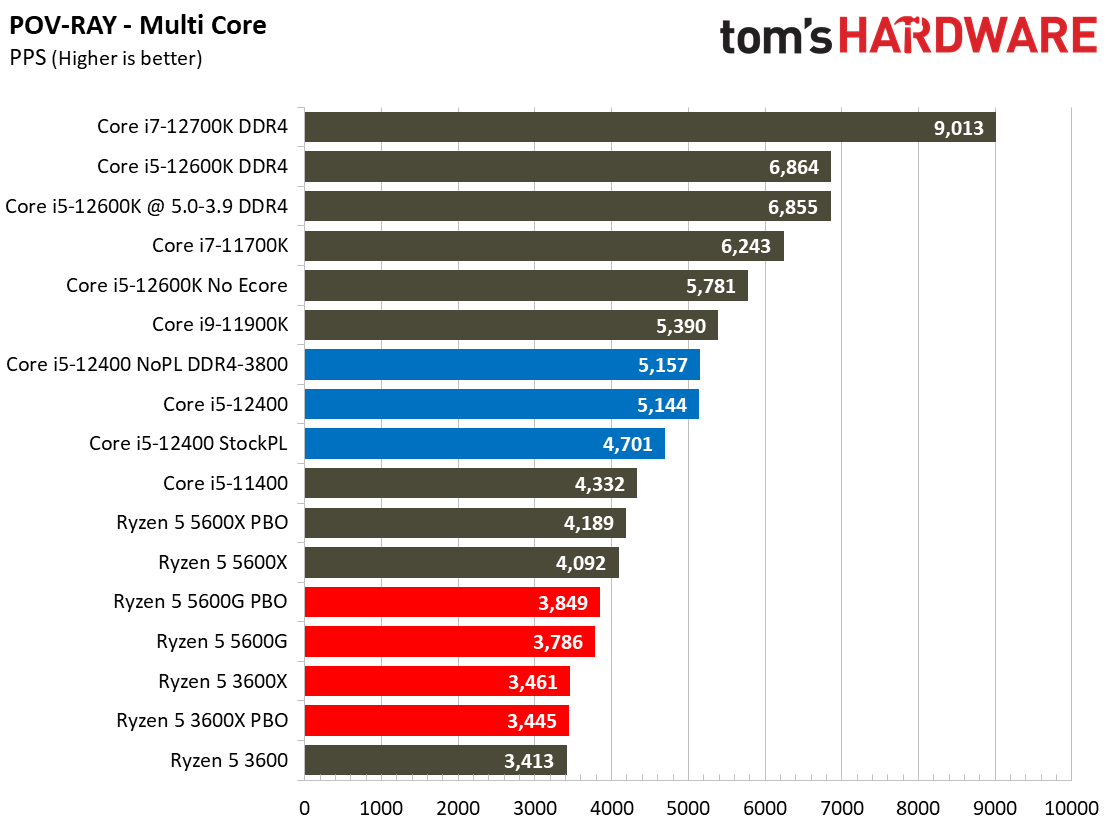
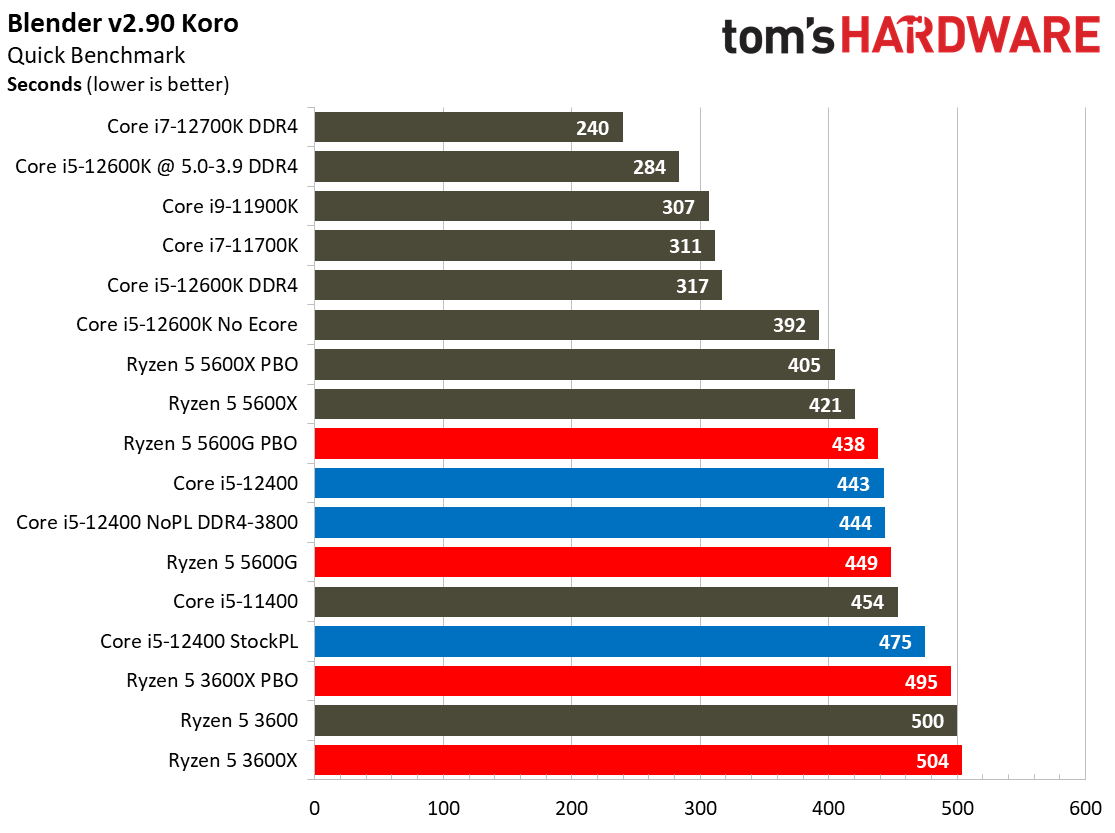
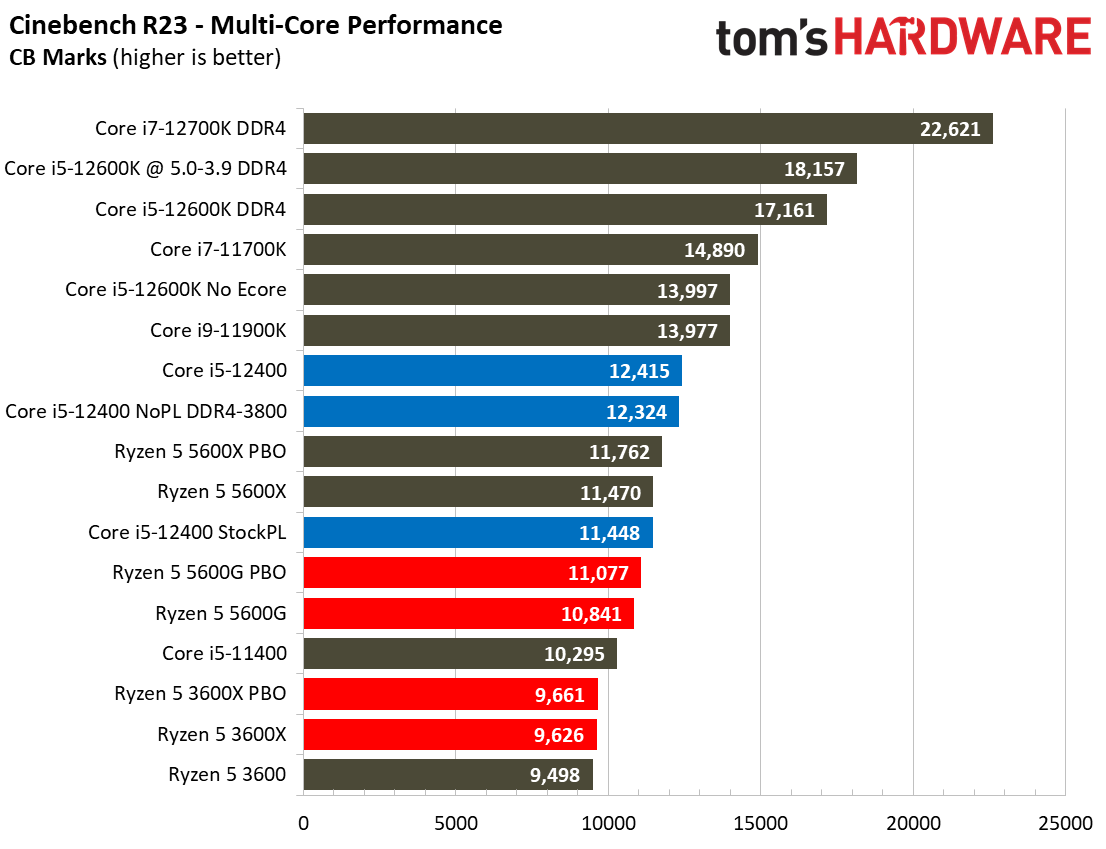
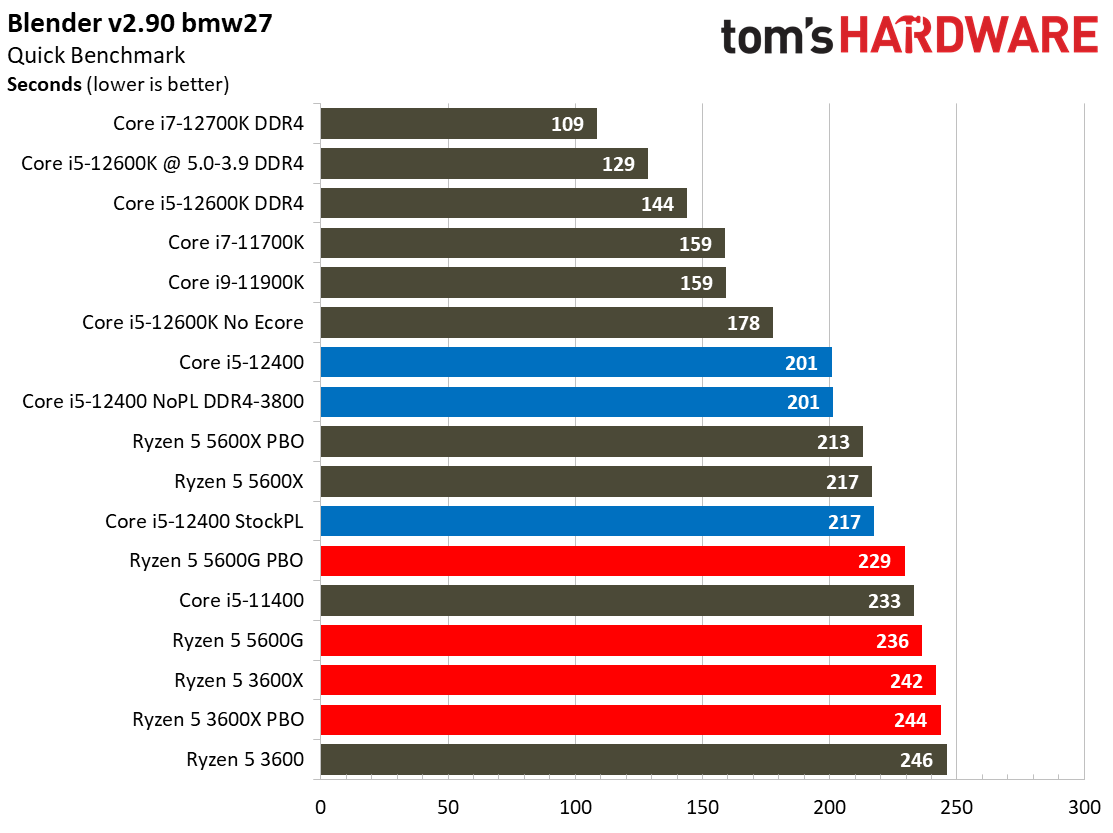
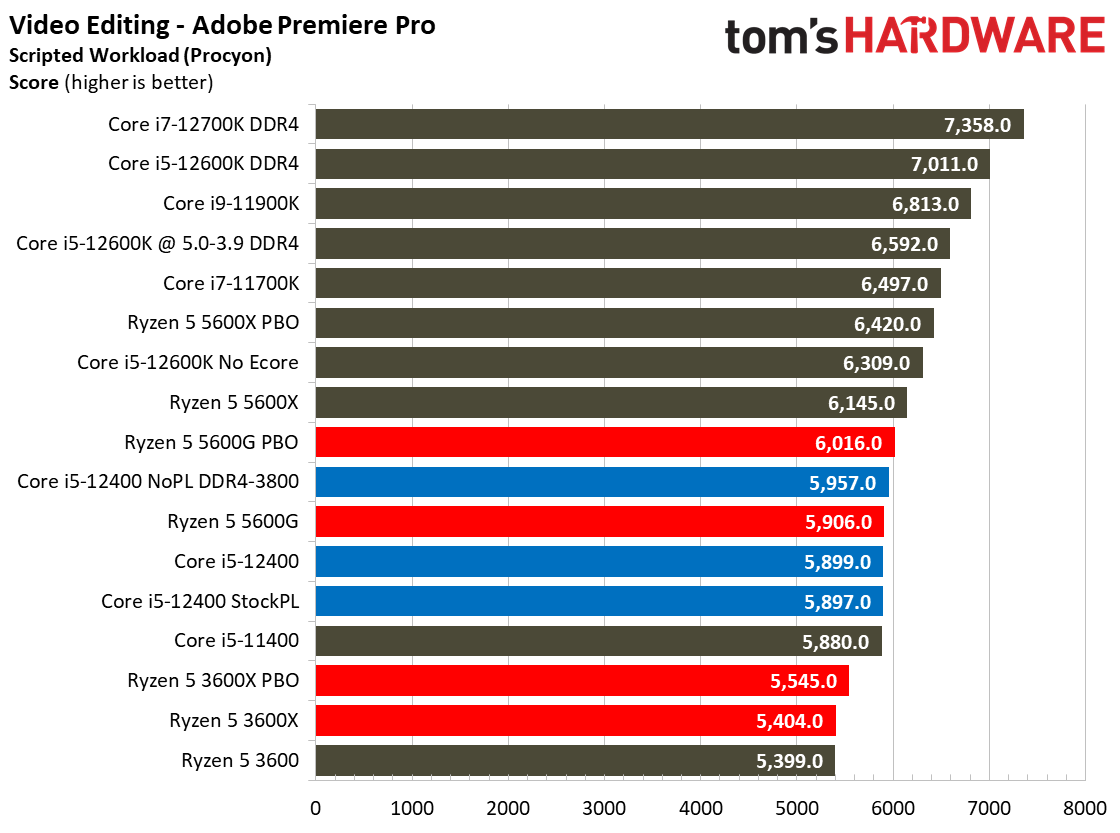


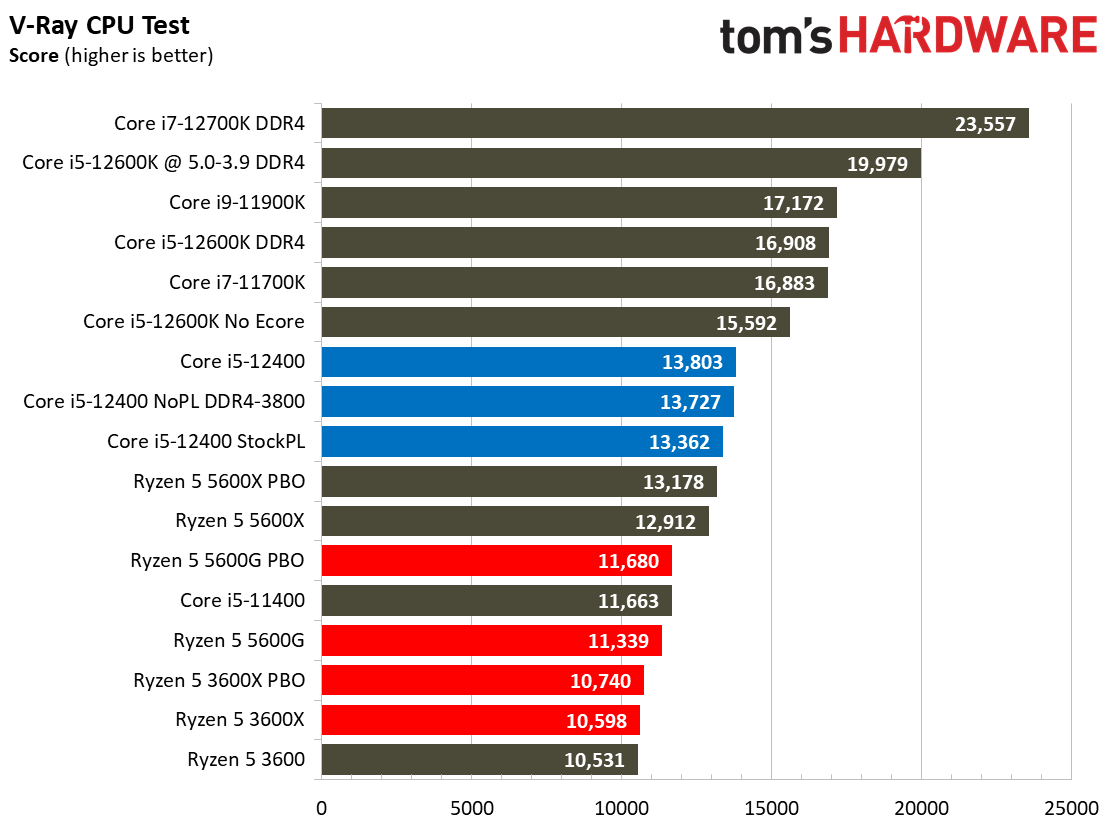
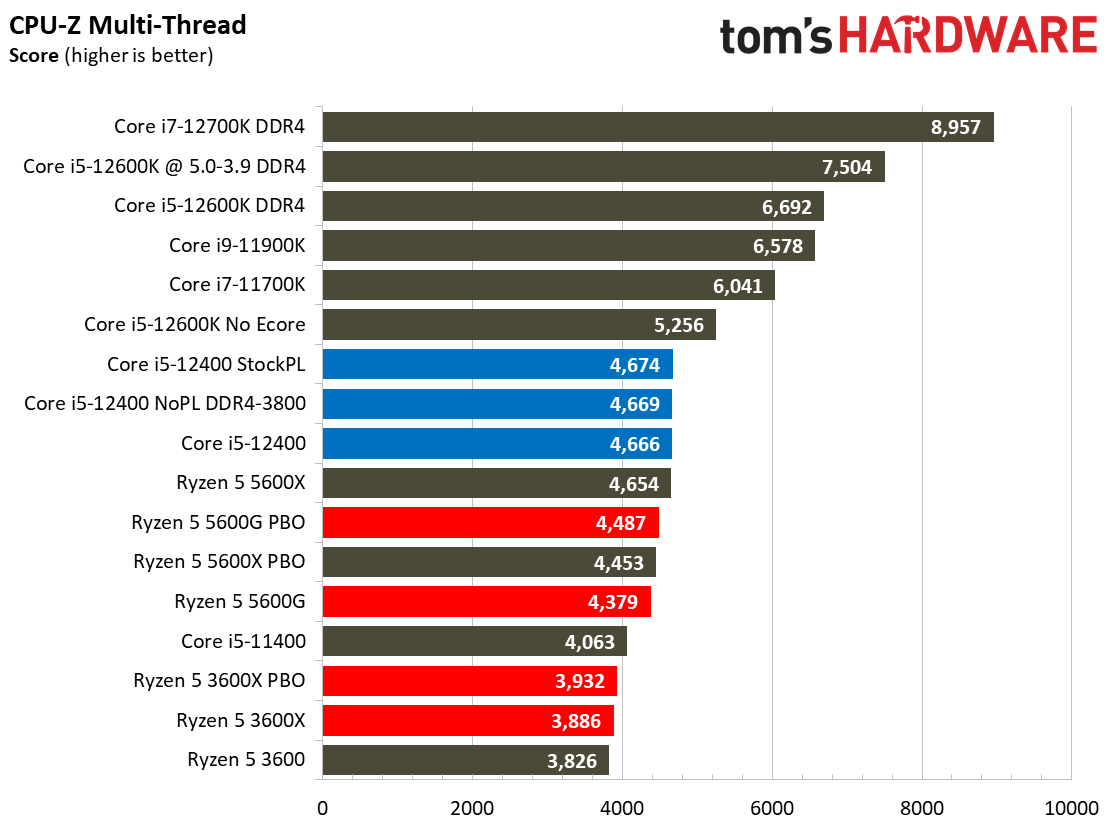
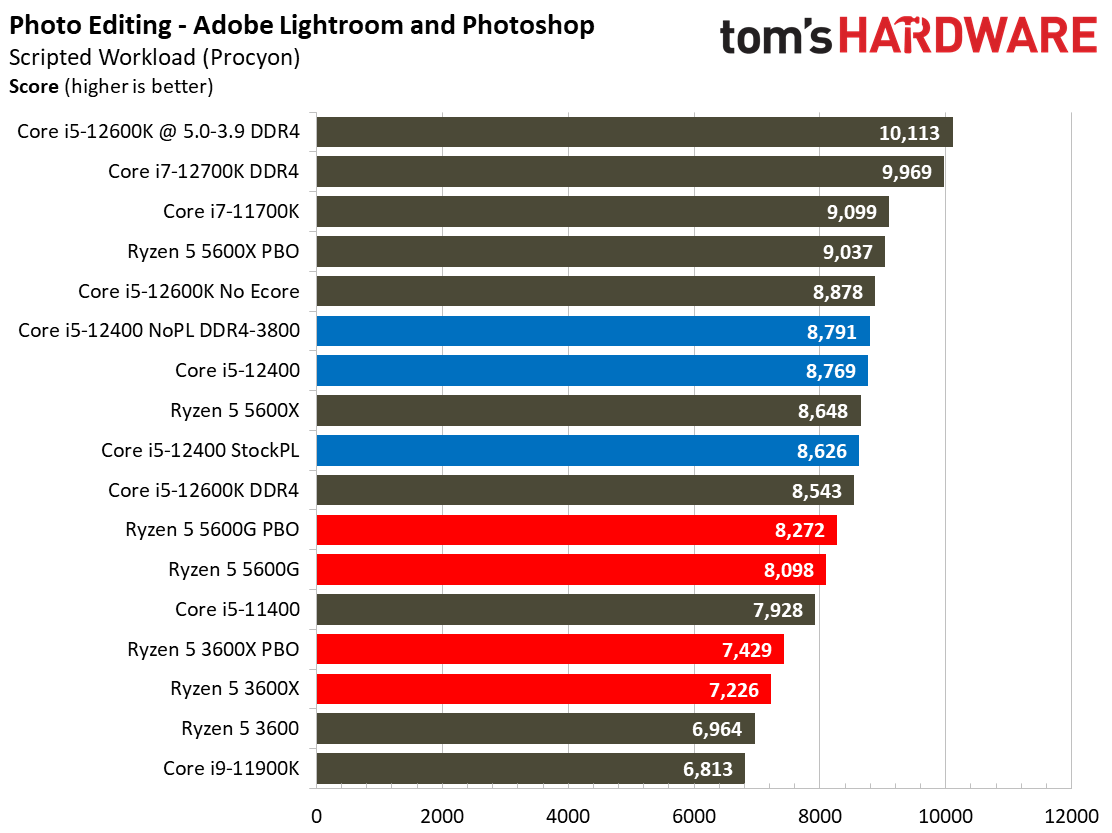
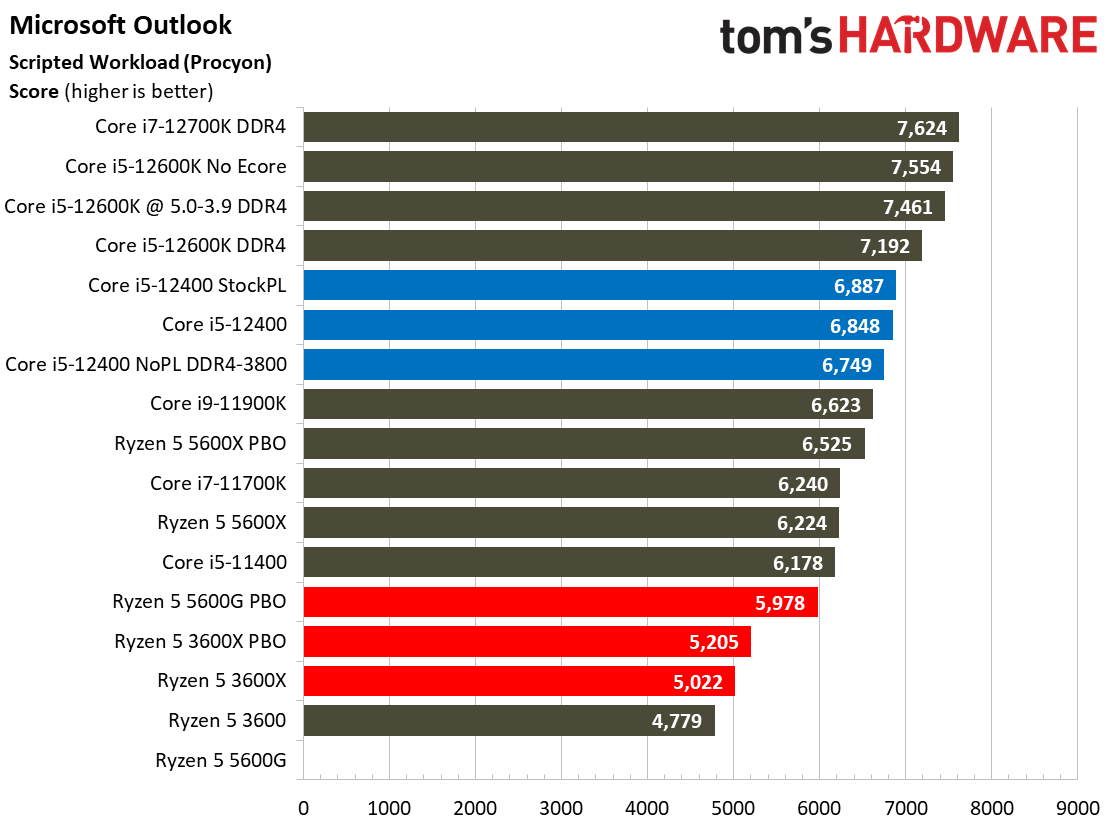
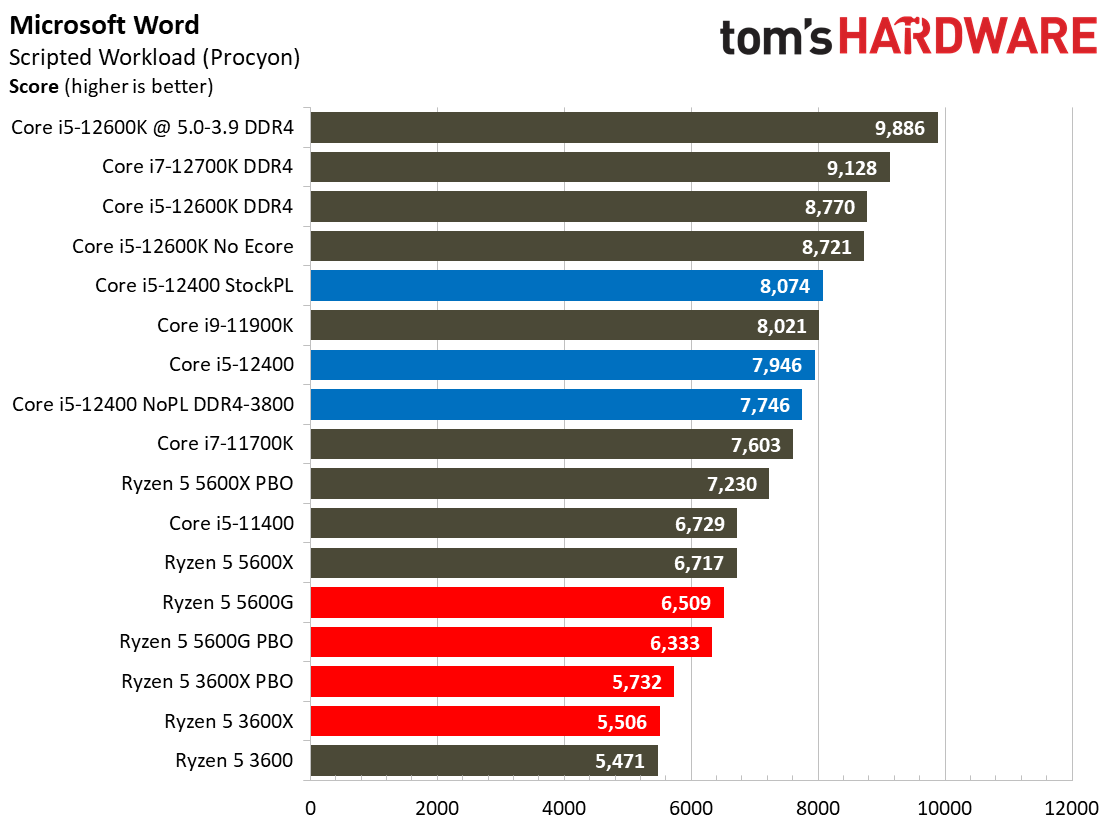

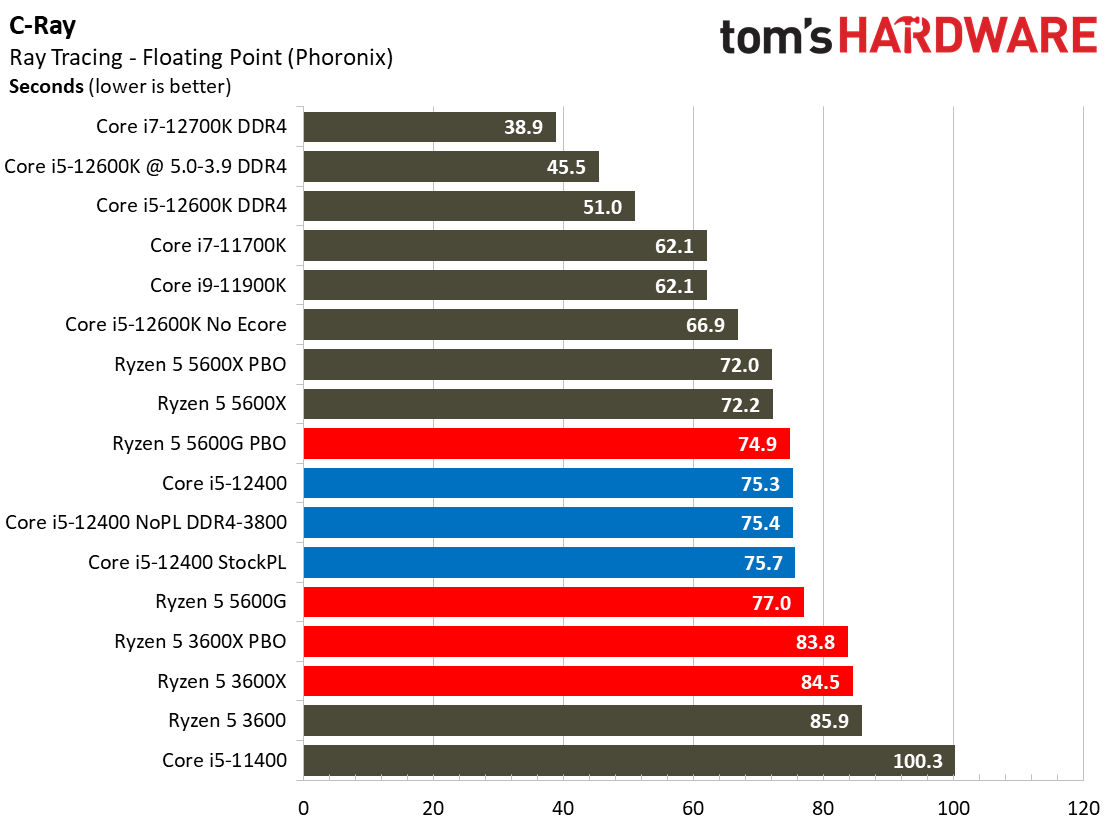
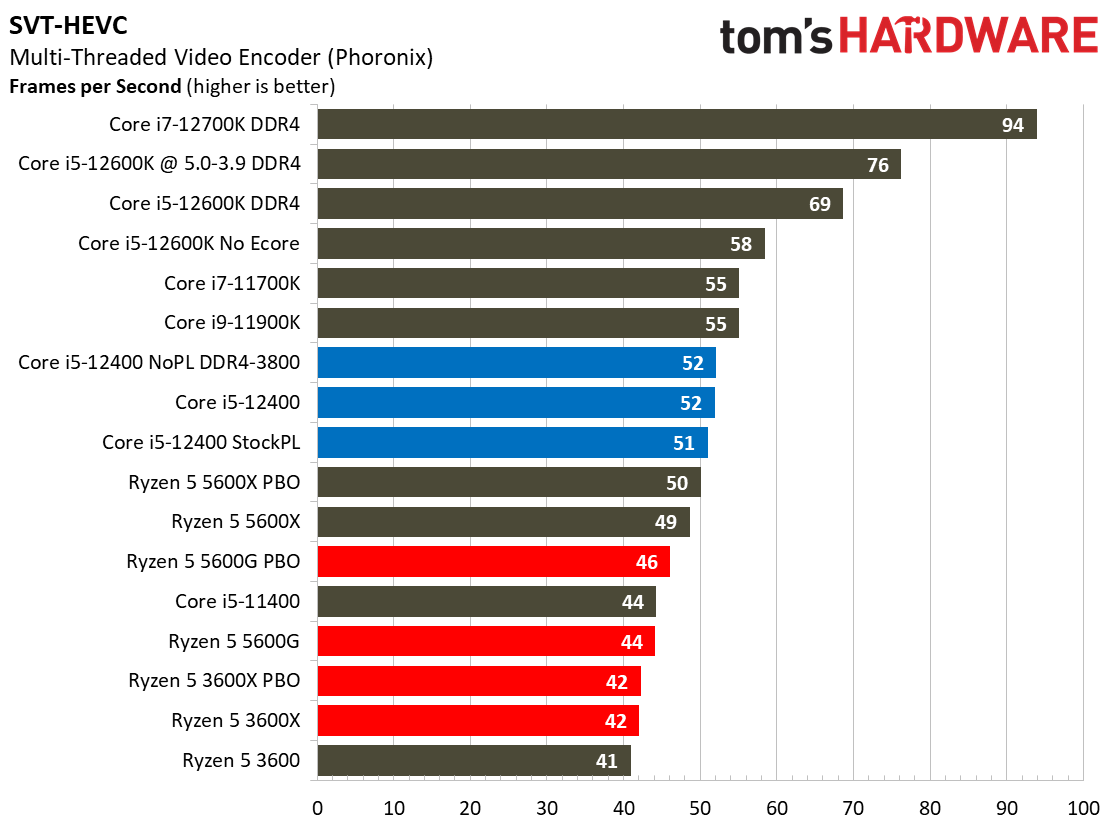

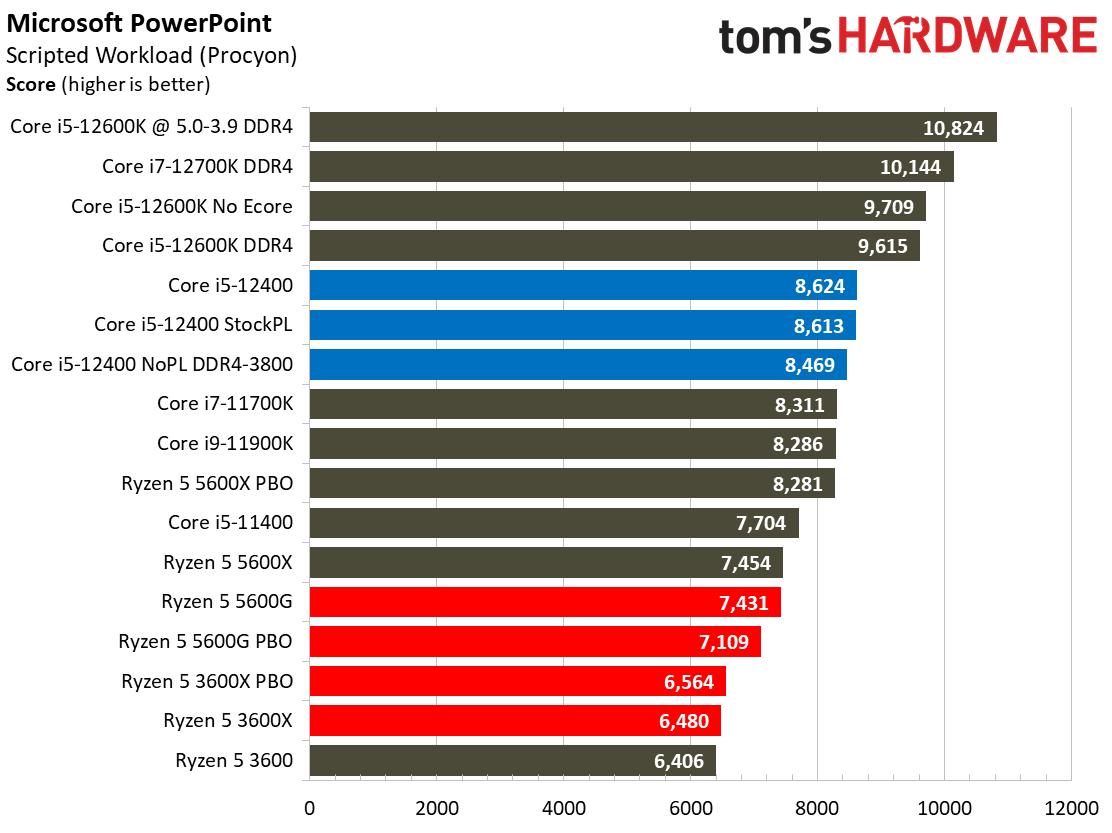
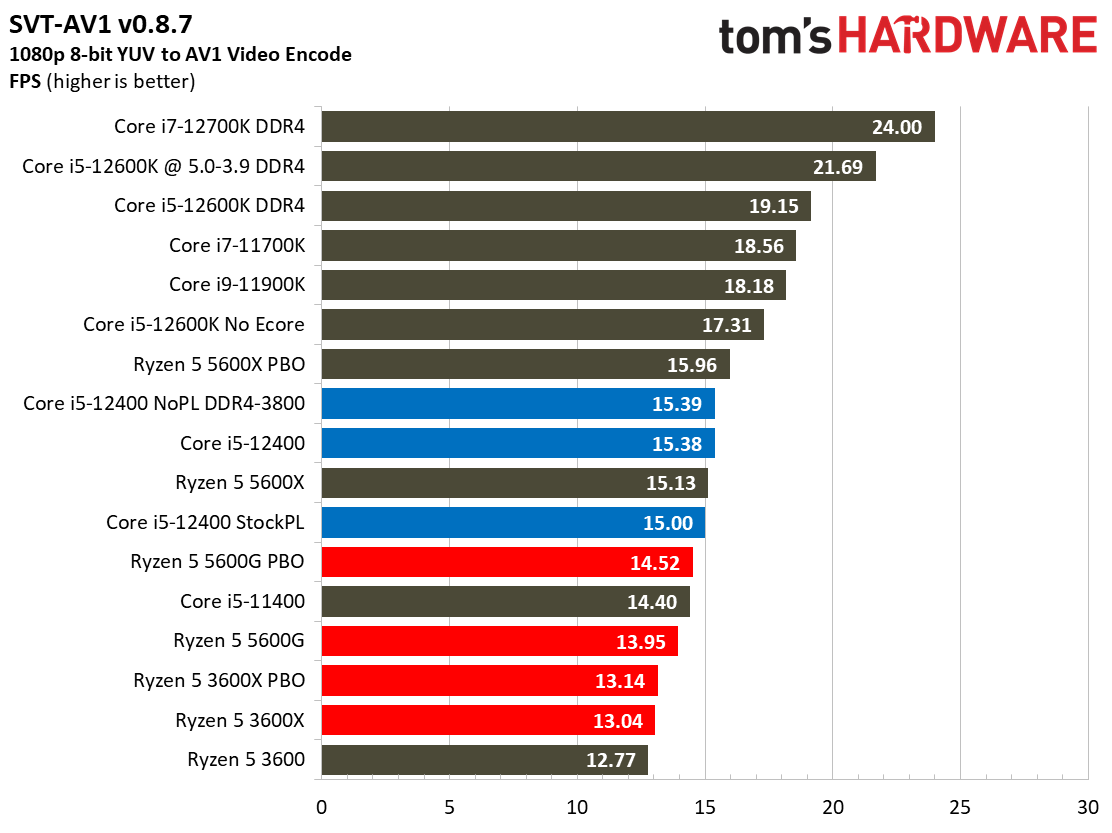

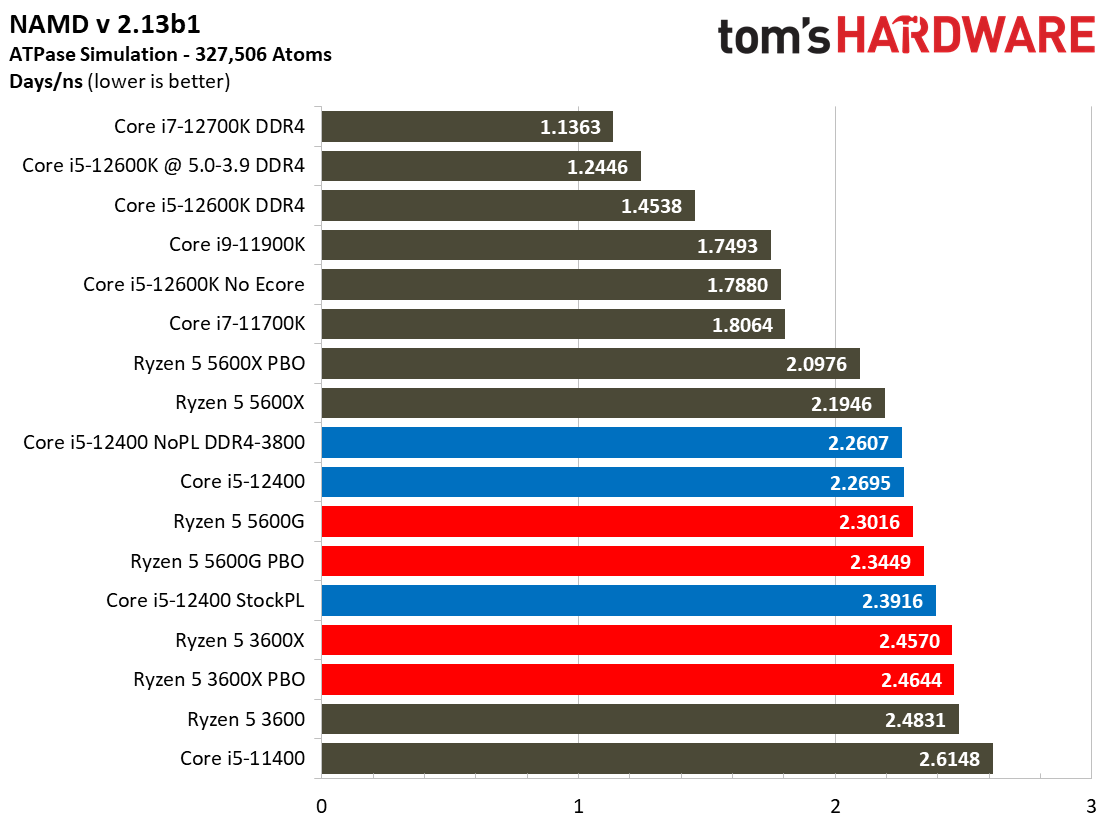
The 12400 is incredibly competitive against the Ryzen 5 models in threaded workloads, even beating the potent Ryzen 5 5600X by 2.3% at standard settings and 6.7% after tuning both chips. That's impressive given the 12400's much more forgiving price tag, but as you'll see in the benchmarks above, the Ryzen 5 5600X does carve out wins in more than a few of those applications.
We see larger gains over the Ryzen 5 5600G, 3600X, and 3600, with the stock 12400 taking leads of 15.8%, 22.4%, and 23.6%, respectively. Frankly, AMD really doesn't have any worthy competing chips at this price point for this type of work.
Removing the power restrictions gives the Core i5-12400 a 7% boost in our cumulative measure of threaded performance, allowing it to beat the overclocked Ryzen 5 5600X, not to mention the rest of the competing Ryzen chips.
Winner: Intel
Given its price point, the Core i5-12400 offers an incredible blend of performance in both single- and multi-threaded apps that simply can't be beaten. You'll have to look to Intel's own Alder Lake family for faster single-threaded performance, and the 12400 often beats the price-comparable Ryzen models (and even the $100 more expensive Ryzen 5 5600X) in threaded applications by convincing margins. If you need more threaded horsepower, Intel's Core i5-12600K offers a 21% boost over the 12400 due to its additional E-cores and is officially overclockable, but you'll have to fork out some extra cash for the privilege.
Overclocking: Intel Core i5-12400 vs AMD Ryzen 5 5600X and Ryzen 5 5600G
Intel's Core i5-12400 isn't an overclockable part, so you shouldn't be able to manipulate core clocks, though you can remove power limits and overclock the memory. However, enterprising motherboard manufacturers have found a way to sidestep Intel's restrictions and allow BCLK overclocking, which in turn has led to spectacular overclocking results with "locked" processors.
As you would expect, Intel has said this is an unsupported practice. As we've seen in the past with other similar workarounds, we expect that Intel will alter its microcode to prevent such efforts soon by locking out BCLK overclocking. Therefore you won't be able to update your BIOS to newer versions if you want to continue to leverage BCLK overclocking. Additionally, Intel theoretically could push microcode updates via Windows Update, which could provide another avenue to disable BCLK overclocking. Since we expect the feature to be disabled soon, we won't take BCLK overclockability into account for scoring in this round.
Intel has long kept overclocking as a feature of its pricey K-series chips and Z-series motherboards, while AMD freely allows overclocking with all SKUs on almost any platform (except A320). Intel has made strides with its overclocking, though. For example, the Core i5-12400 is a locked chip, but you can overclock the memory on Z-, B- and some H-series motherboards. You can also lift the power limits, which serves as a sort of quasi-overclock (definitely not as effective) that will boost performance in some threaded applications and gaming, all while technically remaining within the definition of stock settings (and thus warrantied).
Memory overclocking allows tuners to extract more performance from the chips, particularly in gaming, via easy-to-use XMP profiles or manual tuning. Naturally, the rules around Intel's Gear 1 and Gear 2 modes apply here, and you'll want to stick with the low-latency Gear 1 for most practical use-cases (especially gaming). For the Core i5-12400, the effective limit of Gear 1 operation is around DDR4-3800. That means you can buy a reasonably-priced XMP-equipped memory kit and reap pretty substantial benefits.
AMD's Ryzen chips are all fully overclockable. However, these chips come with innovative boost technology that largely consumes most of the available frequency headroom, so there is precious little room for bleeding-edge clock rates. In fact, all-core overclocking with AMD's chips is lackluster; you're often better off using its auto-overclocking Precision Boost Overdrive 2 (PBO2) feature that boosts multi-threaded performance. AMD also has plenty of Curve Optimization features that leverage undervolting to increase boost activity.
However, it's always important to remember that chip quality can vary for both vendors, so the silicon lottery always comes into play. That will apply to any unsupported BCLK overclocking for the Core i5-12400, along with the standard memory supported memory overclocking capabilities — integrated memory controller (IMC) quality has a big impact on how well the Core i5-12400 can support overclocked memory in the Gear 1 configuration.
Winner: AMD
Intel has long locked all overclocking features to K-series chips on Z-series motherboards, but the company has made strides by allowing memory overclocking for non-K processors on almost all chipsets that support Alder Lake (except some H-series boards).
However, this is still a far cry from AMD's practice of allowing full core and memory overclocking with all of its chips and nearly all chipsets (except A320). That gives AMD the win in the overclocking category, but bear in mind that some of the AMD chips in this face-off can't beat the Core i5-12400 in gaming and application benchmarks, even after overclocking.
Power Consumption, Efficiency, and Cooling: Intel Core i5-12400 vs AMD Ryzen 5 5600X and 5600G


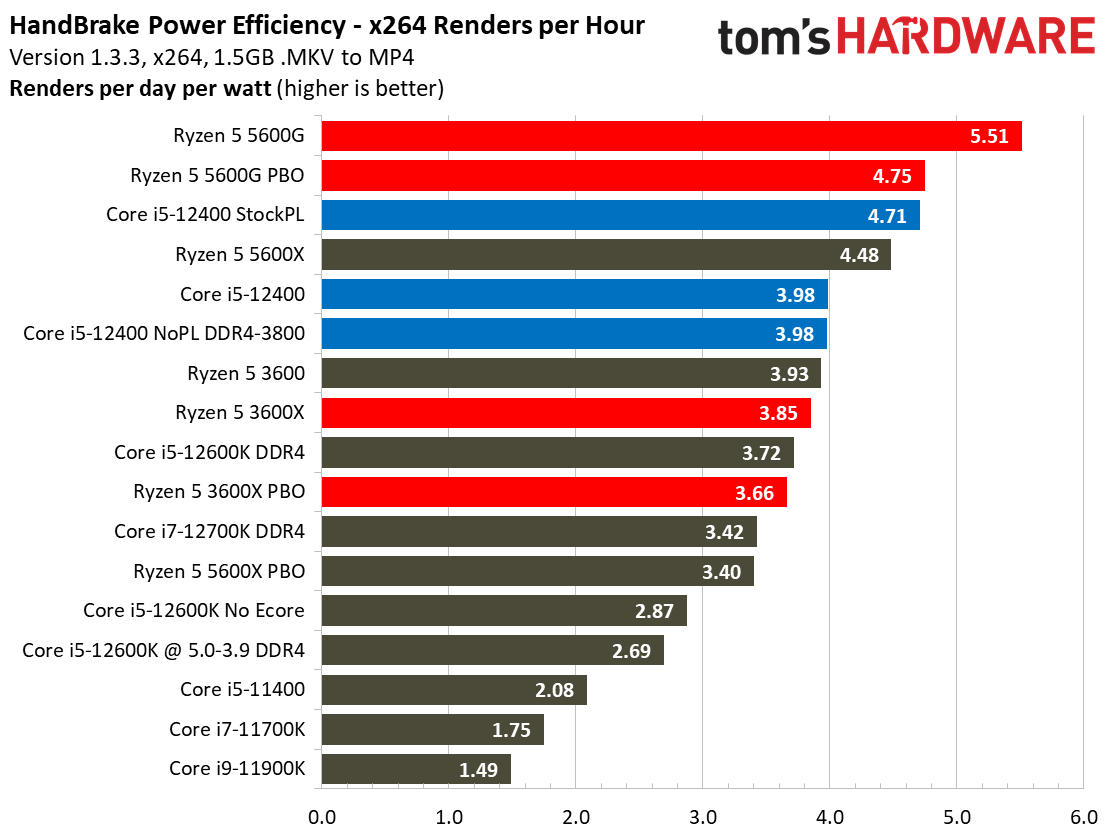

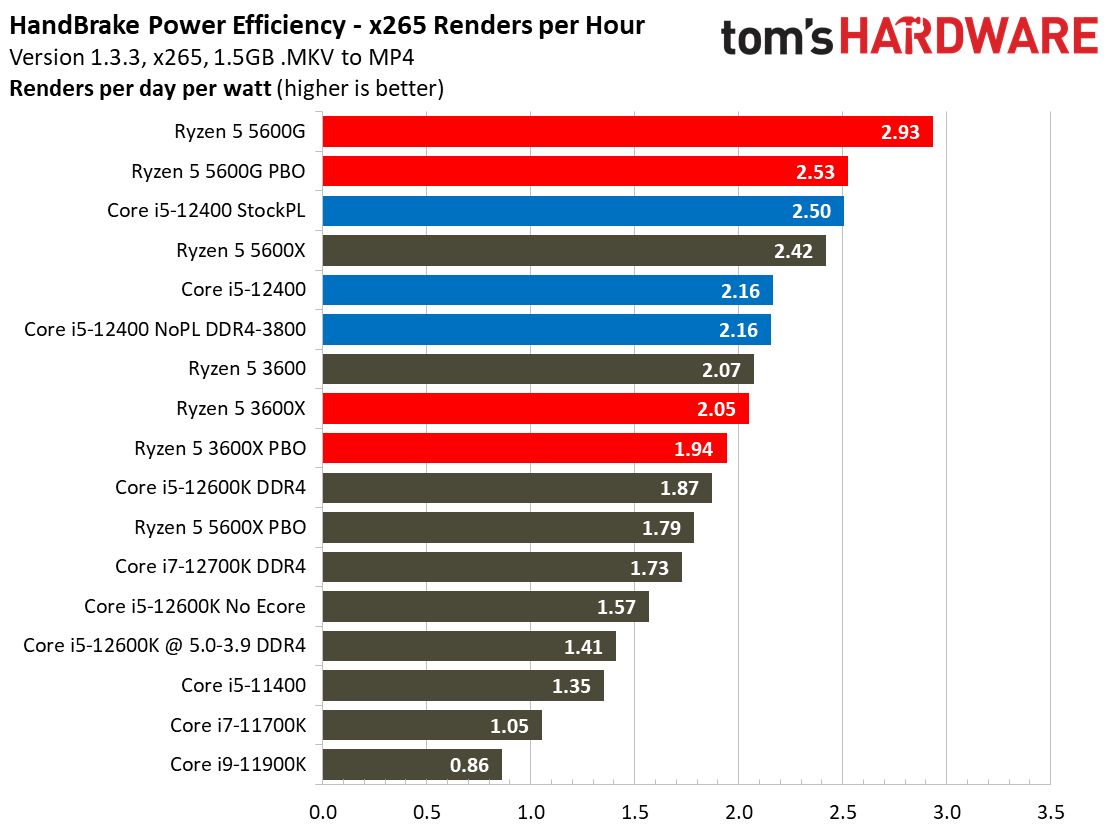

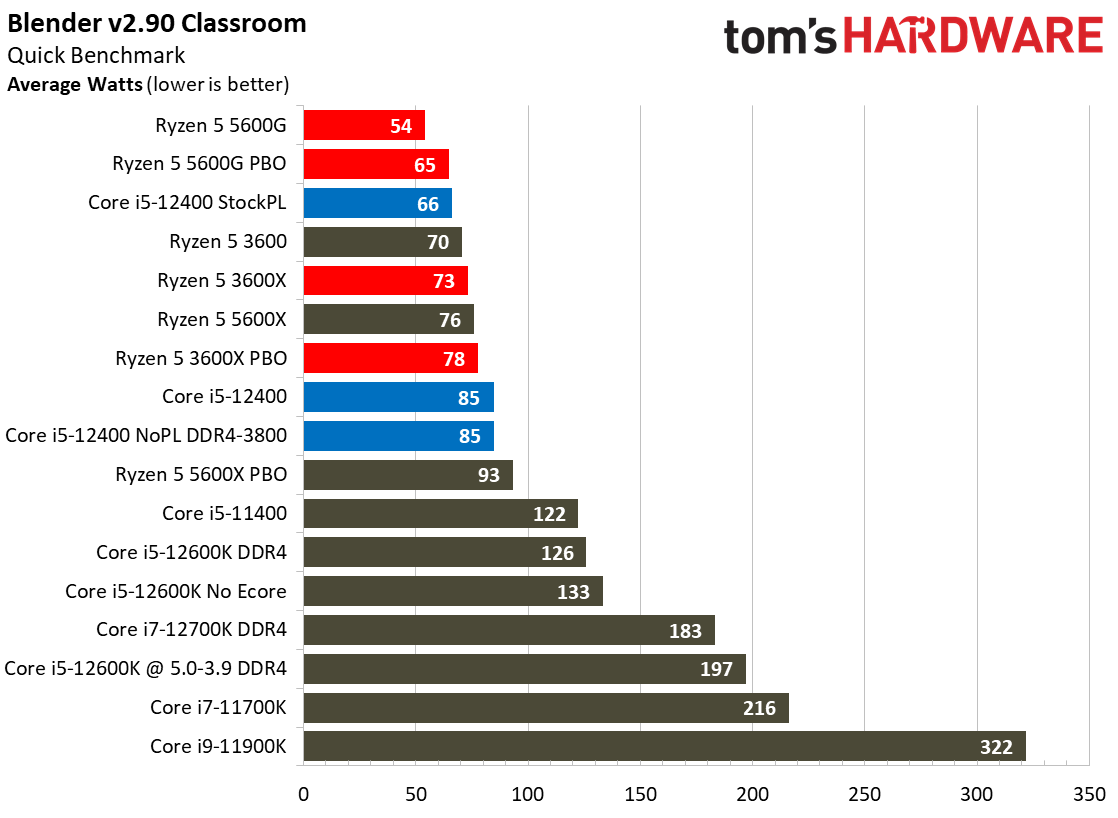


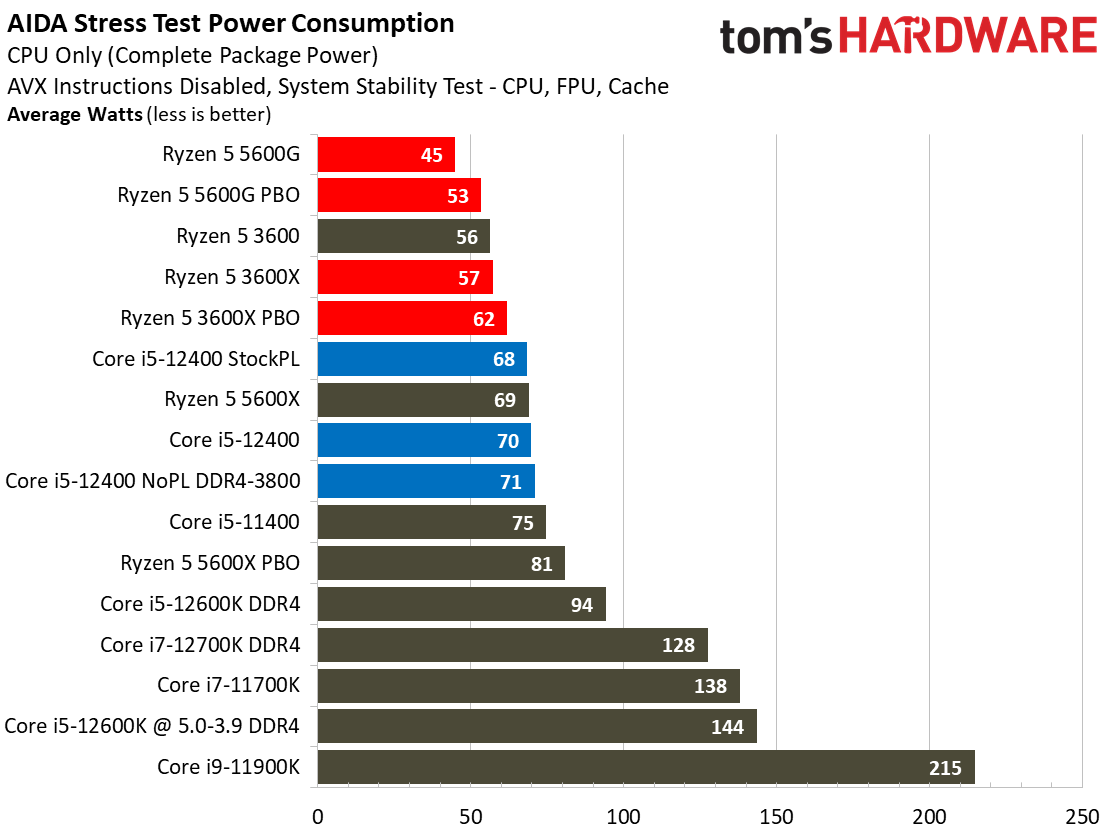
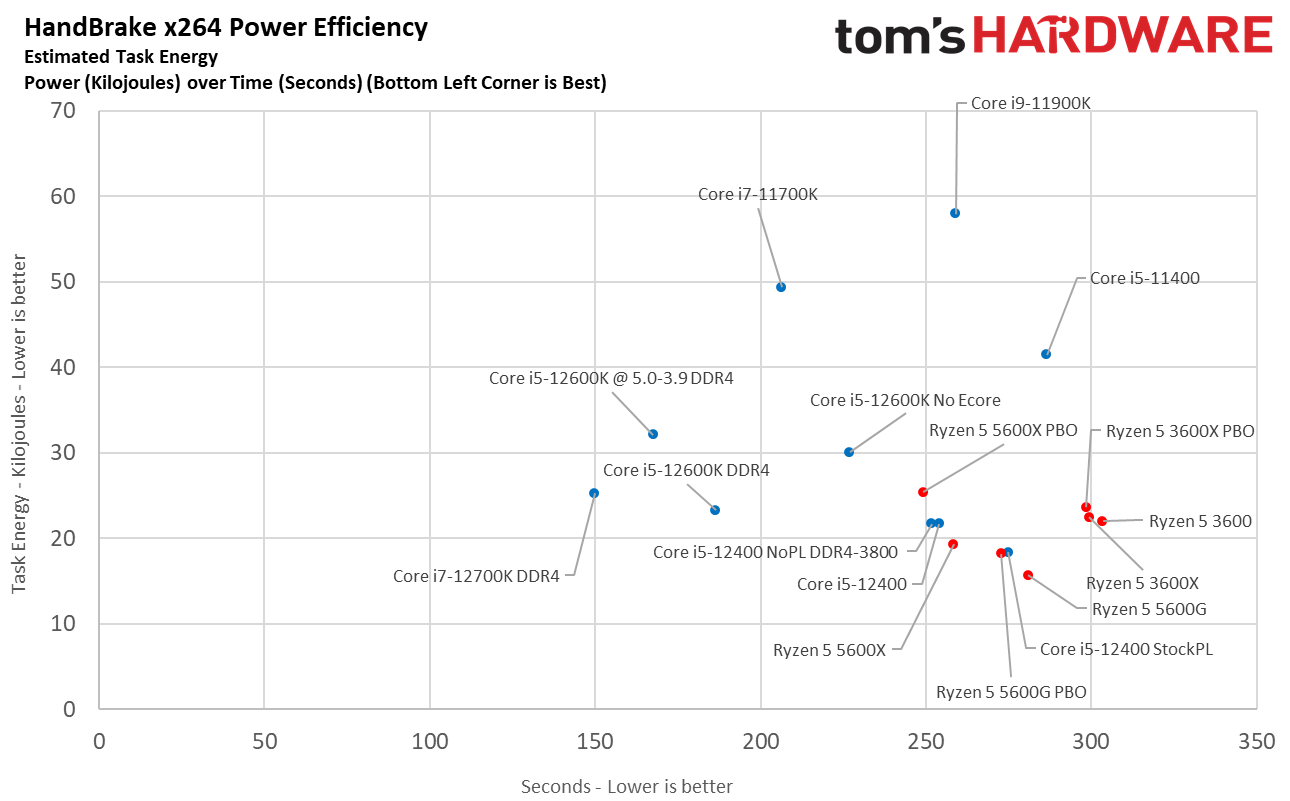


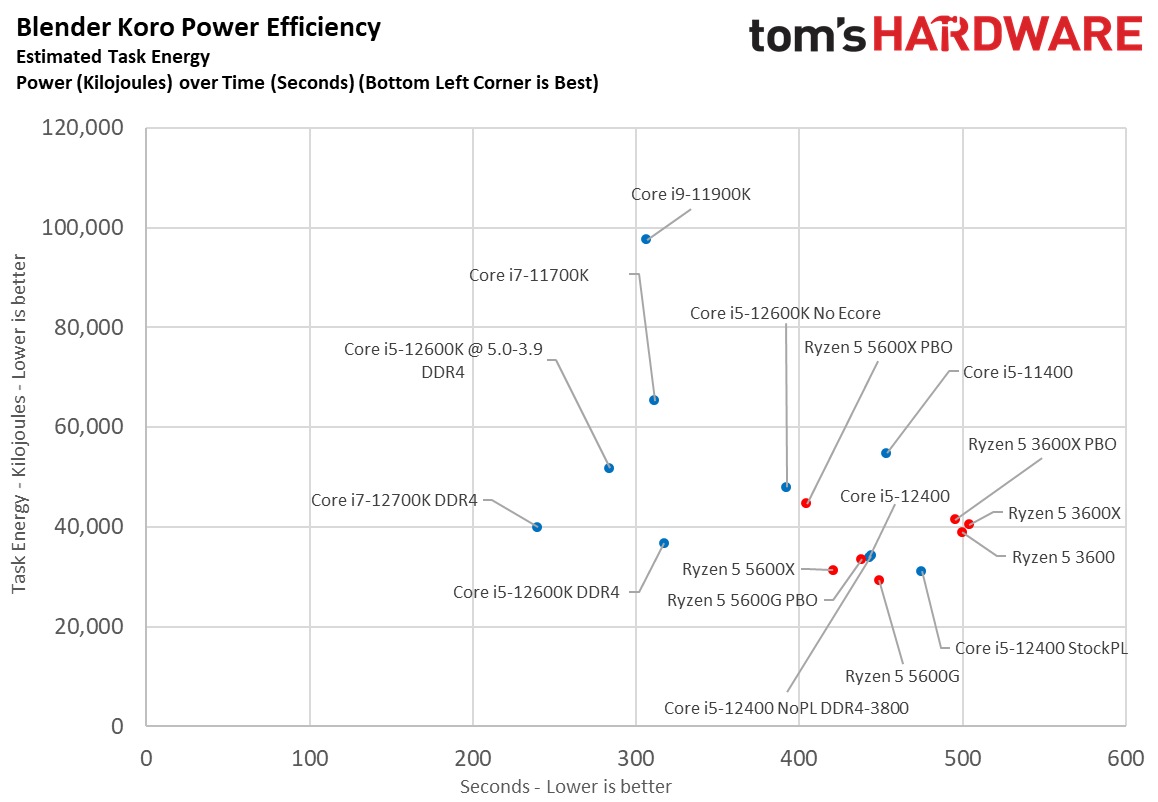
Intel's Alder Lake marks an overdue and drastic improvement to the company's power consumption and efficiency. The new Intel 7 process reduces power consumption and improves efficiency. For the more expensive models, those improvements also come from the new architecture that shuffles heavily-threaded work to smaller, more efficient cores (E-cores). But while the Core i5-12400 lacks the advantage of E-cores, it actually proves to be the most power-efficient Alder Lake chip we've tested.
Overall, the Ryzen processors are still the most power-efficient chips we've ever tested, but Alder Lake closes the gap significantly. However, Intel's improvement here is noteworthy: We measured a peak of 88W with the 12400 with the power limits lifted, while the previous-gen 11400 peaked at a whopping 145W.
Peak power consumption isn't the most important metric, though. The Core i5-12400 is also faster than its predecessor. As you can see in our renders-per-day measurements, the Core i5-12400 is nearly twice as efficient as the previous-gen 11400, and is more efficient than the Ryzen 5 5600X, which offers comparable performance.
The last four slides in the above album give us a different view of power efficiency. Here we calculate the cumulative energy required to perform a given task. We plot this 'task energy' value in Kilojoules on the left side of the chart. These workloads are comprised of a fixed amount of work, so we can plot the task energy against the time required to finish the job (bottom axis) to give us a better look at efficiency.
Bear in mind that faster completion times and lower task energy are ideal. That means processors that are closest to the bottom left corner are best. It's easy to see that Intel has made a massive generational improvement here; the Core i5-12400 is far more efficient than the 11400.
However, AMD still holds the advantage in all of the key power criteria, with the Ryzen 5000 models retaining the crown of the most efficient desktop CPUs that we've ever tested by a slim margin.
Winner: AMD
Intel has made plenty of progress, but AMD still holds the crown of the most power-efficient chips even though the margin has gotten slimmer, largely due to the single-die Ryzen 5000G models. The Ryzen 5000 chips generally consume less peak power, and some models can also accomplish more work per unit of power consumed. That results in superior power consumption, efficiency, and thermal output, so you'll end up with a cooler and quieter system.
Pricing: Intel Core i5-12400 vs AMD Ryzen 5 5600X and Ryzen 5 5600G
The Core i5-12400 has a suggested price point that ranges from $192 to $199, but you can ditch the integrated graphics and go with the Core i5-12400F for $167 to $174, which is an incredible value if you plan on using a discrete GPU. In terms of modern AMD competitors, the Ryzen 5 5600X lands at around $299 while the 5600G costs $259.
Both Ryzen 5000 models command a significant premium that simply isn't worth the level of performance. AMD has abandoned the value segment of the market, so we can only find price-competitive chips from Team Red by stepping back to the previous-gen Zen 2-powered Ryzen 3000 series. However, as you can see in the benchmarks above, the $240 Ryzen 5 3600X and $200 Ryzen 5 3600 can't compete with the Core i5-12400 in performance benchmarks.
All of the chips come with a bundled cooler, which levels the playing field when you're only buying the chip.
In chip pricing alone, the Core i5-12400 obviously dominates the competition. However, while the CPU is one of the most important components in the build, it is but one factor in the equation — you also need a motherboard and memory. Naturally, DDR5 memory is the elephant in the room, but that's pretty simple: You should expect to pay a massive early adopter premium for DDR5 memory, and more for the higher-end DDR5 motherboards. If you're looking for bang-for-the-buck, DDR5 is off the table for now. Luckily, DDR4 offers nearly the same performance as DDR5 in most applications, and high DDR5 pricing effectively removes it from the conversation for this class of chip.
You should plan on using a 600-series B- or H-series motherboard with the 12400, and there are a plethora of options available that support DDR4 memory. AMD's AM4 motherboard ecosystem is generally less expensive, but AM4's connectivity options have come a bit long in the tooth.
In contrast, Intel offers more robust connectivity options, like PCIe 5.0, but you do have to pay extra for those capabilities. Even the lower-end 600-series motherboards carry higher pricing than many of the options in AMD's robust AM4 motherboard ecosystem, often to the tune of a ~$50 premium, but Intel's lower chip pricing, not to mention performance advantages, make up for the higher motherboard costs. We're also in the early days of B660 availability, and pricing typically cools off after a few months (though shortages could prevent that).
Winner: Intel
As long as you skip DDR5 memory, Intel wins in the overall pricing category. While lower-end 600-series motherboards are more expensive than comparable AM4 motherboards, the Core i5-12400's lower chip pricing and superior performance outweigh the additional motherboard costs. meaning you get more value for your dollar.
Bottom Line: Intel Core i5-12400 vs AMD Ryzen 5 5600X and Ryzen 5 5600G
| Row 0 - Cell 0 | Intel Core i5-12400 | AMD Ryzen 5 5600X / 5600G |
| Features and Specifications | X | Row 1 - Cell 2 |
| Gaming | X | Row 2 - Cell 2 |
| Application Performance | X | Row 3 - Cell 2 |
| Overclocking | Row 4 - Cell 1 | X |
| Power Consumption, Efficiency and Cooling | Row 5 - Cell 1 | X |
| Pricing | X | Row 6 - Cell 2 |
| Total | 4 | 2 |
The Core i5-12400 takes a four-to-two lead in this Core i5-12400 vs Ryzen 5 5600X and Ryzen 5 5600G battle. Like the rest of the Alder Lake family, the Core i5-12400 comes to market with excellent pricing as part of Intel's price war with AMD, which is particularly painful as Intel attacks the sub-$200 segment that AMD has largely abandoned.
The $192 Core i5-12400 beats the more expensive $299 Ryzen 5 5600X and $259 Ryzen 5 5600G in key areas. At stock settings, the Core i5-12400 is 1.9% faster than AMD's venerable ~$299 Ryzen 5 5600X in gaming, an impressive showing for a chip that costs $100 less. It feels unfair to compare the Ryzen 5 5600G to the Core i5-12400, but the $259 5600G is the only Zen 3 chip close to this price class. Regardless, with a discrete GPU, the Core i5-12400 is 16.8% faster than the 5600G but costs $50 less.
Putting the Core i5-12400 up against AMD's price-comparable models isn't a fair fight; the Core i5-12400 beats them by huge margins. That's because the Ryzen 5 3600X and 3600 are several years old and have the previous-gen Zen 2 architecture. But, again, these are the only price-comparable chips from the AMD camp. In gaming, the Core i5-12400 is 22.7% and 26% faster than the Ryzen 5 3600X and 3600, respectively.
The Core i5-12400 now reigns as the budget gaming CPU champ. Of course, you also have to consider that you can get the graphics-less Core i5-12400F for ~$25 less. That's an excellent price point for access to this level of performance.
The 12400 is just as impressive in lightly-threaded apps. In fact, not a single Ryzen processor beat the Core i5-12400 in our cumulative measure of single-threaded performance, and that includes the $800 Ryzen 9 5950X. You'll have to look to other Alder Lake chips to find faster performance in single-threaded work.
In threaded work, the Core i5-12400 is 'only' 12.4% faster than the previous-gen Core i5-11400, but we still see impressive performance over competing Ryzen chips. Even though the 5600X carves out some wins in some applications, the 12400 is 2.3% faster in threaded work and 6.7% faster after overclocking. That's surprising given the 5600X's $100 premium. Frankly, AMD doesn't have any worthy competing chips for threaded work at the 12400's price point. We see larger leads for the 12400 over the Ryzen 5 5600G, 3600X, and 3600, with the Core i5-12400 taking leads of 15.8%, 22.4%, and 23.6%, respectively.
The Core i5-12400 has a much more modern platform than AMD's AM4 motherboards. Access to DDR5 and PCIe 5.0 interfaces adds cost, but support for DDR4 enables less-expensive B660 motherboards that help reduce that overhead. In either case, the Core i5-12400 provides more than enough performance to justify the platform costs. You also won't need DDR5 memory to unlock the best gaming performance, and that's a plus because DDR5's high pricing doesn't make sense for this class of chip.
The 12400 delivers solid performance in all manner of threaded productivity applications and beats even the highest-end Ryzen 5000 chips in single-threaded work. The Core i5-12400 also serves up incredible levels of gaming performance but at a much lower price point than any comparable AMD processor, setting a new bar for budget gaming chips. For gamers looking for the best value, the Core i5-12400 is now the uncontested best value CPU for gaming.
- MORE: Best CPUs for Gaming
- MORE: CPU Benchmark Hierarchy
- MORE: AMD vs Intel
- MORE: All CPUs Content
| Intel Socket 1700 DDR4 (Z690) | Core i7-12700K, Core i5-12600K, Core i5-12400 |
| Row 1 - Cell 0 | MSI Z690A WiFi DDR4 |
| Row 2 - Cell 0 | 2x 8GB Trident Z Royal DDR4-3600 - Stock: DDR4-3200 14-14-14-36 |
| Intel Socket 1200 (Z590) | Core i9-11900K, Core i7-11700K, Core i5-11400 |
| Row 4 - Cell 0 | MSI Z590 Godlike |
| Row 5 - Cell 0 | 2x 8GB Trident Z Royal DDR4-3600 - Stock DDR4-3200/2933 Gear 1 |
| AMD Socket AM4 (X570) | Ryzen 5 5600X, 5600G, 3600X, 3600 |
| MSI MEG X570 Godlike | |
| Row 8 - Cell 0 | 2x 8GB Trident Z Royal DDR4-3600 - Stock: DDR4-3200 14-14-14-36 |
| All Systems | Gigabyte GeForce RTX 3090 Eagle - Gaming and ProViz applications |
| Row 10 - Cell 0 | Nvidia GeForce RTX 2080 Ti FE - Application tests |
| 2TB Sabrent Rocket 4 Plus | |
| Silverstone ST1100-TI | |
| Row 13 - Cell 0 | Open Benchtable |
| Row 14 - Cell 0 | Arctic MX-4 TIM |
| Row 15 - Cell 0 | Windows 11 Pro |
| Cooling | Corsair H115i, Custom loop |

Paul Alcorn is the Editor-in-Chief for Tom's Hardware US. He also writes news and reviews on CPUs, storage, and enterprise hardware.
-
larkspur There are six categories right? It is 4 to 2 not four to three.Reply
We're focusing on our Windows 11 test results in this article, but given that the 12400 doesn't have integrated graphics, you should experience similar results in Windows 10.
Huh? What?
And the charts have ? for the 12400's price? Pretty sure those are known.
I know your Chiefs are playing today, but this article is a mess. -
AlB80 Chapter title: "Gaming Benchmarks and Performance: Intel Core i5-12400 vs AMD Ryzen 5 5600X and Ryzen 5 5600G"Reply
Chapter diagrams: 5600X beats 12400 with score 13 vs 7.
Chapter verdict: "In either case, Intel holds the lead. Winner: Intel" -
jacob249358 Reply
not to mention ¨ryzen 7 5600g¨ ¨the $259 5600g¨ and then 2 sentences later ¨the $249 5600g¨ were you under the influence while writing?larkspur said:There are six categories right? It is 4 to 2 not four to three.
Huh? What?
And the charts have ? for the 12400's price? Pretty sure those are known.
I know your Chiefs are playing today, but this article is a mess. -
Mattzun For value gaming, the actual comparison is gaming performance with integrated graphics on the 5600G vs integrated graphics on the 12400.Reply
None of the listed comparisons matter at all.
The 3050's look like they or going to sell for 400+ and even the horrid 6500's are going for 280+
Neither counts as a value option
At least one site has mentioned that the sub 200$ GPU market (value gaming) is effectively dead.
Between shipping costs, wafer availability, component costs, and the ability to sell as many of the high margin, high cost GPUs as you can make, there won't be sub 200$ GPUs in any quantity.
Still hoping to see 6000 series APUs vs some Intel 12th/13th gen with beefed up graphics or a cheap, low end sub 150$ actual price ARC GPUs. -
spongiemaster Reply
They meant no eCores, not no integrated graphics.larkspur said:Huh? What?
And the charts have ? for the 12400's price? Pretty sure those are known.
I know your Chiefs are playing today, but this article is a mess. -
spongiemaster Reply
Not sure why so many people on message boards are promoting this false theory that no one has usable GPU's. Like millions of gamers all had their perfectly usable graphics card die just as the 3000 series hit and mining took over and they have no serviceable GPU. Steam hardware survey shows there are a whole lot of gamers with 3000 series GPU's. There are even more with 2000 series and they didn't exactly become obsolete and not able to play games when the 3000 series was released. The overwhelming majority of games will play just fine on 10 series cards. You can't play at ultra settings at 4k, but that doesn't matter to the more than 2/3's of gamers still using a 1080p monitor and there are currently more gamers playing at resolutions below 1080p than above it. You don't need a 3080 to game at 1080p or below.Mattzun said:For value gaming, the actual comparison is gaming performance with integrated graphics on the 5600G vs integrated graphics on the 12400.
None of the listed comparisons matter at all.
The 3050's look like they or going to sell for 400+ and even the horrid 6500's are going for 280+
Neither counts as a value option
At least one site has mentioned that the sub 200$ GPU market (value gaming) is effectively dead.
Between shipping costs, wafer availability, component costs, and the ability to sell as many of the high margin, high cost GPUs as you can make, there won't be sub 200$ GPUs in any quantity.
Still hoping to see 6000 series APUs vs some Intel 12th/13th gen with beefed up graphics or a cheap, low end sub 150$ actual price ARC GPUs.